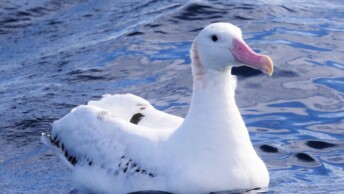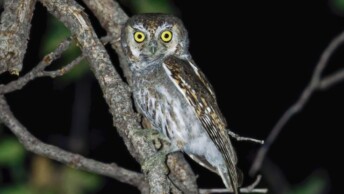Ducks are among the most familiar and diverse waterfowl of North America. Belonging to the order Anseriformes, alongside geese and swans, they range from tiny teal to heavy-bodied sea ducks and stifftails. These birds inhabit nearly every type of wetland on the continent, from prairie potholes and boreal lakes to coastal bays and urban ponds.
This guide introduces the many types of ducks found across the United States and Canada, highlighting their identification, habits, and habitats. It covers the native species that make up the core of North America’s duck diversity, along with a few introduced and regularly occurring vagrants that add to the variety.
Mallard
Anas platyrhynchos
- Identification: Medium-large duck with males showing a green head, chestnut breast, and gray body; females mottled brown with orange-marked bill.
- Where found: Breeds across most of Canada and the United States; winters south through the U.S. and into northern Mexico. Common in wetlands, lakes, rivers, and urban parks.
- How to spot: Look for the bold blue speculum with white borders on the wing; males also show curled black tail feathers. Females give the familiar loud quack.
- Conservation status: Least Concern globally; North American populations stable overall, though locally affected by habitat loss, hunting, and hybridization.
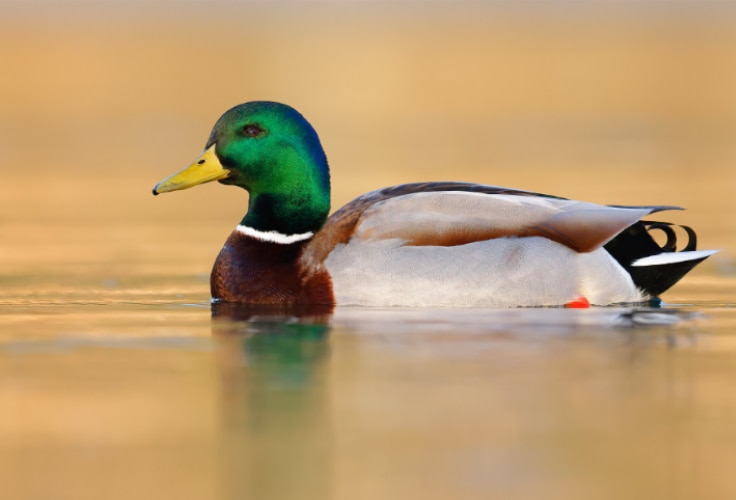
The mallard is North America’s most widespread and familiar duck, thriving in both wild wetlands and city parks. Adults are medium to large ducks, measuring 50 to 70 centimeters (19.7 to 27.6 inches) in length. Their stocky build, dabbling feeding style, and strong adaptability make them one of the most recognizable waterfowl on the continent.
The species is strongly sexually dimorphic. Males in breeding plumage have an iridescent green head, narrow white neck-ring, chestnut breast, grayish body, and black tail with upturned central feathers. The wing shows a vivid blue speculum bordered by white. Females are mottled brown with a pale belly, dark eyeline, and orange bill blotched with black. Juveniles resemble females but are darker and less crisply marked. Males in late summer eclipse plumage also resemble females but retain their larger size and some structural clues such as the slightly curled tail.
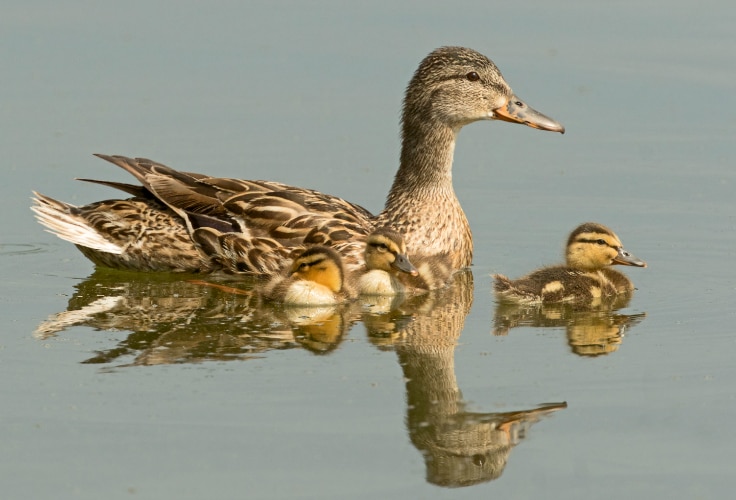
In the field, mallards are best identified by the wing patch: a blue to violet speculum with bold white borders, visible in flight or at rest. The male’s loud whistles and the female’s familiar quacking call also aid recognition. They are dabbling feeders, often seen tipping up in shallow water, but also graze on land and forage in crop fields. Diet shifts seasonally from insects and aquatic invertebrates in summer to seeds, acorns, and agricultural grains in fall and winter.
Mallards breed across nearly all of Canada and the northern and central United States, nesting on the ground near water under cover of vegetation. In winter they occur throughout the continental U.S. and into northern Mexico, concentrating along flyways and in regions with open water and available food. They use a wide range of habitats, from marshes, lakes, and rivers to estuaries, reservoirs, and even ornamental ponds in urban areas.
This species remains abundant and secure, with populations cycling naturally in response to wetland conditions. It is also the most heavily hunted duck in North America, but regulated harvest has not threatened overall numbers. Threats include habitat loss, pollution, ingestion of lead shot, and hybridization with closely related species such as the American black duck. Thanks to adaptability and careful management, mallards continue to be a cornerstone species of North America’s waterfowl.
Blue-Winged Teal
Spatula discors
- Identification: Small duck with a bold powder-blue wing patch; males show white facial crescent and spotted cinnamon flanks, females mottled brown with pale face arcs.
- Where found: Breeds mainly in prairie potholes of central U.S. and southern Canada; winters in Gulf Coast, Florida, Mexico, Caribbean, and much of South America.
- How to spot: Look for the blue wing patch in flight; males are unmistakable in breeding plumage, while females show a dark eyeline with pale crescents above and below the eye.
- Conservation status: Least Concern globally; populations stable but vulnerable to drought-driven habitat loss and wetland degradation.
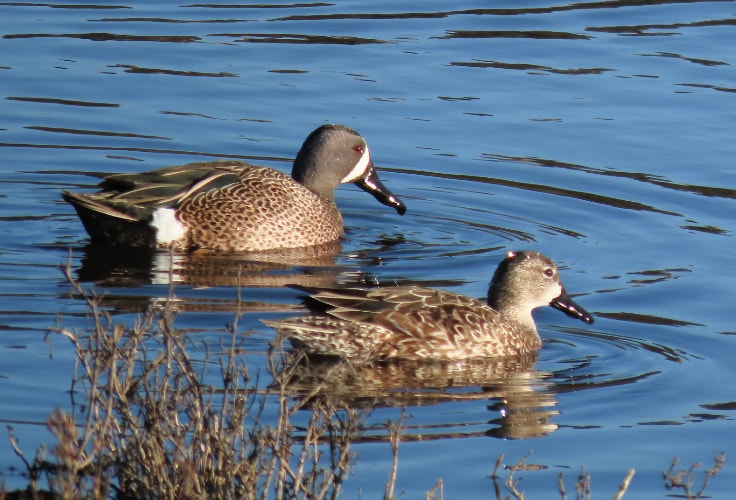
The blue-winged teal is the second most abundant duck in North America, surpassed only by the mallard. Adults are small dabbling ducks, measuring 36 to 41 centimeters (14.2 to 16.1 inches) in length. Their early migration, long southbound flights, and strong association with shallow wetlands make them a notable feature of the continent’s waterfowl scene.
Males in breeding plumage are distinctive, with a gray head marked by a bold white crescent in front of the eye, cinnamon-brown flanks densely speckled in black, and a bright blue forewing patch with a green speculum. Females are mottled brown overall with a dark eyeline, pale eye-arcs, and a subtle bluish wing patch visible in flight. Juveniles closely resemble adult females. In eclipse plumage, males look similar to females but retain a darker bill and traces of the white facial crescent.
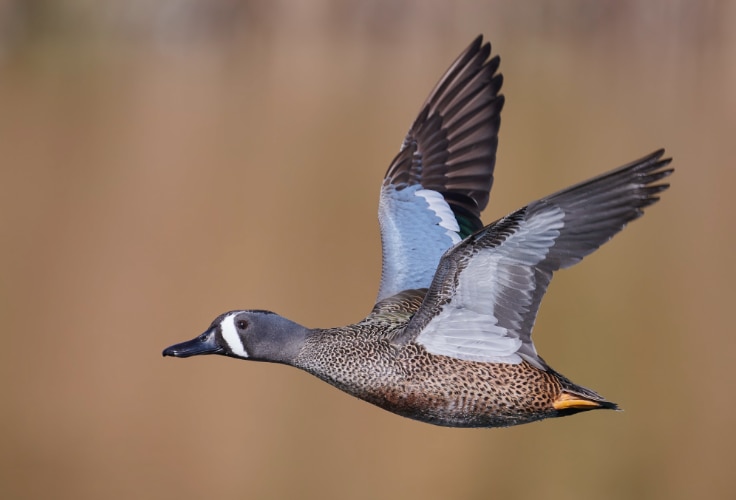
In the field, blue-winged teal are most easily identified by the pale blue patch on the upperwing, especially conspicuous in flight. They sit high on the water and often forage in compact groups, dipping their heads or tipping up in shallow wetlands. Males give high-pitched whistles, while females quack loudly when flushed. They are dabbling feeders, consuming aquatic invertebrates, seeds, duckweed, and algae, and occasionally gleaning grain in flooded fields.
This species breeds widely across the Prairie Pothole Region of the north-central United States and southern Canada, with highest densities in the Dakotas, Manitoba, and Saskatchewan. Breeding also occurs locally across much of the eastern and western United States, often in areas with shallow wetlands and grassland cover. In winter, blue-winged teal migrate farther than most North American ducks, traveling to the Gulf Coast, Florida, Mexico, the Caribbean, and deep into South America as far as Argentina. Nests are usually placed in grasslands close to water, concealed in short to medium vegetation.
The blue-winged teal remain common and secure, with stable populations supported by wetland conservation and programs such as the Conservation Reserve Program, which has expanded grassland nesting cover. Numbers fluctuate with prairie wetland conditions, dropping in drought years. Threats include habitat loss, pesticide use in wintering areas, lead ingestion, and reduced availability of fallow grasslands. Careful management of wetlands and hunting pressure has helped maintain their strong numbers across North America.
Green-Winged Teal
Anas crecca
- Identification: Very small duck with a dark green speculum; males have a chestnut head with a green eye-stripe, females are mottled brown.
- Where found: Breeds widely across Alaska, Canada, and northern U.S.; winters in the southern U.S., Mexico, Caribbean, and Central America.
- How to spot: Look for its tiny size and rapid, agile flight; males show a chestnut-and-green head pattern, females are darker than other teals.
- Conservation status: Least Concern globally; populations stable or increasing, though vulnerable to wetland loss and hunting pressures.

The green-winged teal is North America’s smallest dabbling duck, but also one of the most numerous. Adults measure 31 to 39 centimeters (12.2 to 15.4 inches) in length, making them noticeably smaller than mallards or even blue-winged teal. Despite their size, their buoyant flight, early courtship displays, and habit of gathering in immense flocks make them highly visible on migration and wintering grounds.
Adult males in breeding plumage show a chestnut head with a bold green patch running from the eye to the crest, a speckled pinkish breast, fine gray flanks, and a vertical white line at the shoulder. The wings feature a metallic green speculum bordered by buff and white. Females are mottled brown overall, darker than other teals, with a fine dark eyeline and small bill. Juveniles resemble females, and males in eclipse plumage also look similar but may retain hints of the head pattern.

In the field, green-winged teal are best recognized by their small size, quick twisting flight, and whistling wingbeats. Males give a clear “prip-prip” whistle during courtship, while females quack in shorter bursts. They dabble in shallow wetlands, tipping up or skimming food from the surface, but occasionally dive when pursued by predators. Their diet includes seeds of sedges, grasses, and aquatic plants, along with insects, mollusks, and crustaceans, shifting opportunistically with the season and habitat.
This species breeds across Alaska, most of Canada, and the northern United States, especially in boreal forests, parklands, and wetlands with dense cover. Nests are concealed on the ground in grasses or sedges, usually within 200 meters (660 feet) of water. In winter, green-winged teal concentrate in the southern United States, Mexico, the Caribbean, and Central America, favoring shallow marshes, rice fields, estuaries, and vegetated mudflats. Large roosting flocks, sometimes numbering tens of thousands, are a common winter sight.
Green-winged teal populations are stable or increasing across their range. Their remote northern breeding areas provide some protection from habitat loss, though wetland drainage and agricultural development farther south pose risks. They are heavily hunted, with over a million birds harvested annually in North America, but adaptive management of bag limits has helped keep harvest levels sustainable. Overall, the species remains secure and abundant.
Gadwall
Mareca strepera
- Identification: Medium-sized duck; males gray overall with black rump and white speculum, females mottled brown with thinner orange-edged bill and white wing patch.
- Where found: Breeds across western and central North America, with smaller populations in the east; winters in southern U.S., Mexico, and locally the Caribbean.
- How to spot: Look for the plain, gray male with a white speculum in flight; females resemble female mallards but have a slimmer bill and paler face.
- Conservation status: Least Concern globally; North American populations numerous and stable, aided by habitat creation and adaptability to artificial wetlands.
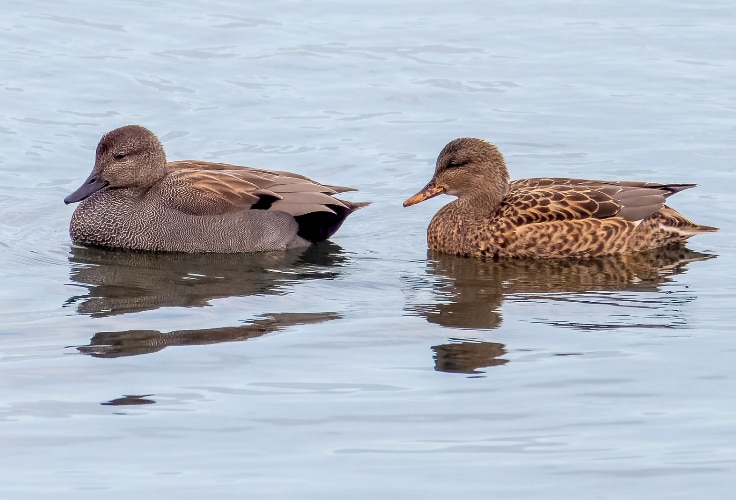
The gadwall is a medium-sized dabbling duck, measuring 46 to 58 centimeters (18.1 to 22.8 inches) in length. Though often overlooked for its subdued colors, it is a widespread and increasingly common species across North America. Its adaptability to both natural and artificial wetlands has allowed it to expand its range in recent decades.
Adult males in breeding plumage are finely patterned gray with a darker brown head, black rump, and black undertail coverts. A bold white wing patch, bordered by black and chestnut, is most visible in flight. Females are mottled brown with an orange-lined bill and a smaller but still visible white speculum. Males in eclipse plumage resemble females but retain the distinctive wing pattern. Juveniles are also female-like, though typically darker and more heavily streaked.
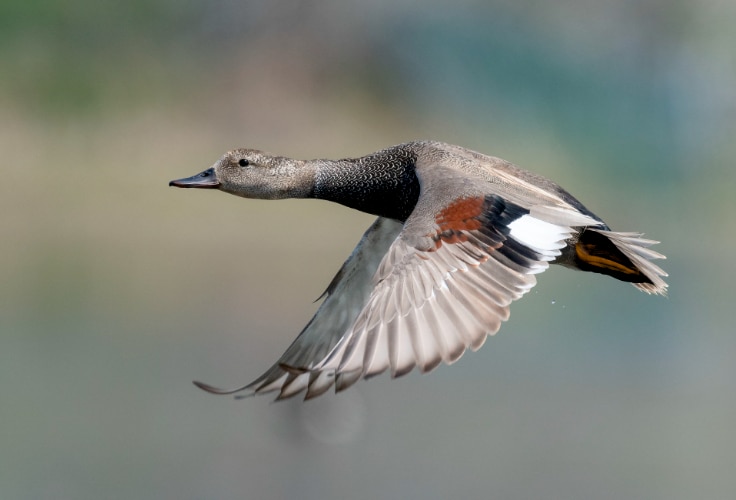
In the field, gadwalls can be identified by their plain gray look compared to other ducks, their black rear end, and the white wing patch flashing in flight. They swim high in the water and feed by dabbling, often tipping forward to graze on submerged plants. Though they rarely dive, they are known to steal food from coots and other waterfowl. In flight, they rise quickly and directly from the water. Vocalizations are distinct: males give a low, reedy “burp” call, while females produce nasal, higher-pitched quacks.
The species breeds widely across the Prairie Pothole Region of the northern United States and southern Canada, extending into Alaska and more locally into the Great Lakes and northeastern states. Nesting occurs in grasslands, sedge meadows, and brushy areas near wetlands, often within dense cover. During winter, Gadwalls concentrate along the southern U.S., Gulf Coast, and into Mexico, with smaller numbers reaching the Caribbean. They favor shallow wetlands, reservoirs, rice fields, and coastal marshes with abundant aquatic vegetation.
Gadwalls remain numerous and secure, with populations benefiting from both wetland conservation and human-altered habitats such as reservoirs and sewage ponds. They are less heavily hunted than mallards or teal, and their reliance on aquatic vegetation makes them less vulnerable to agricultural changes. Overall, they are stable to increasing across North America and considered a species of low conservation concern.
Northern Shoveler
Spatula clypeata
- Identification: Medium-sized duck with a very large, spoon-shaped bill; males have a green head, white chest, and chestnut sides, females are mottled brown.
- Where found: Breeds widely across the Prairie Pothole Region, western and northern North America, and locally in the east; winters in southern U.S., Mexico, Central America, and the Caribbean.
- How to spot: Look for the oversized bill and feeding groups swimming in circles; in flight, note the blue forewing and green speculum.
- Conservation status: Least Concern globally; populations stable, though wetland loss remains a primary long-term threat.

The northern shoveler is one of North America’s most distinctive dabbling ducks, best known for its oversized, spatula-shaped bill. Adults measure 44 to 51 centimeters (17.3 to 20.1 inches) in length. Smaller than a mallard, the shoveler is instantly set apart by its unique feeding adaptations and striking breeding plumage.
Adult males in breeding plumage show a dark green head, bright yellow eyes, white chest, and chestnut flanks, with a black back and pale blue shoulder patch visible in flight. Females are mottled buff-brown with a large orange-based bill and paler face, resembling female Mallards but easily distinguished by bill shape. Both sexes display a green speculum on the secondary wing feathers. Males in eclipse plumage and juveniles resemble females but can be separated by wing pattern and, in young males, brighter wing contrasts.
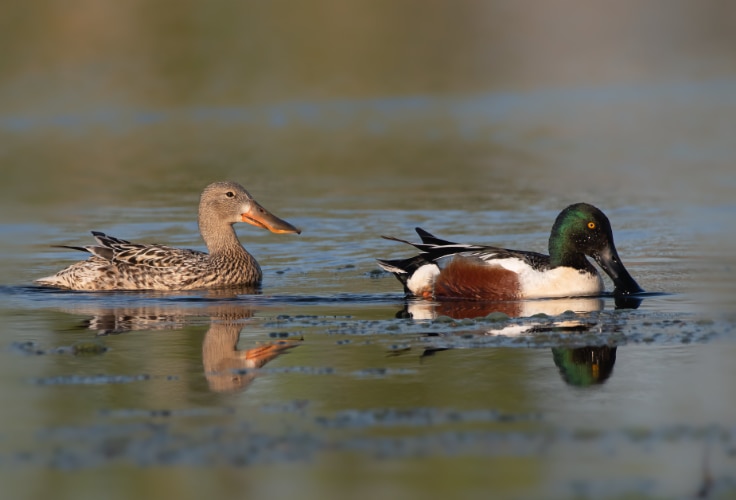
In the field, the spoon-shaped bill is the clearest identification mark, visible at long distances and in flight. Northern shovelers forage by sweeping their bills side to side through shallow water, filtering out small invertebrates and seeds with the comb-like lamellae along the bill edges. They often feed cooperatively, swimming in circles to stir up food. Their flight is direct, with a hunched-neck profile and rattling wing noise on takeoff. Males are also known for their nasal “took” calls and courtship whistles, while females give a series of quacks in various contexts.
This species breeds primarily in the Prairie Pothole Region of the northern U.S. and southern Canada, extending into Alaska, the western U.S., and more locally into the Great Lakes and northeastern states. Nests are placed on the ground in short vegetation, usually close to water. In winter, Northern Shovelers disperse widely across the southern U.S., Gulf Coast, Mexico, Central America, and the Caribbean, favoring shallow wetlands, estuaries, rice fields, sewage ponds, and brackish lagoons. They are most common along the Gulf Coast and in interior Mexican wetlands.
Northern shovelers are abundant and globally secure, with stable populations across North America. As highly specialized filter feeders, they rely on healthy wetlands with rich invertebrate communities. Loss and degradation of wetlands from agriculture and development pose the greatest long-term threats. They are a regular target of waterfowl hunters, though less sought after than mallards or teal, and harvest levels are carefully regulated. Overall, the species remains one of the continent’s most distinctive and widespread dabbling ducks.
American Wigeon
Mareca americana
- Identification: Medium-sized duck with a rounded head, short bluish-gray bill tipped black; males show a white crown and green eye patch; females mottled brown with a plainer face.
- Where found: Breeds from Alaska and western Canada south through the Prairie Pothole Region; winters mainly in western and southern North America.
- How to spot: Look for the male’s white crown and large white shoulder patch in flight; both sexes take off steeply and fly erratically; males give a clear three-note whistle.
- Conservation status: Least Concern globally; populations remain common but show regional declines tied to drought and habitat loss.

The American wigeon is one of North America’s most distinctive dabbling ducks, often called “baldpate” for the male’s pale crown. Adults measure 42 to 59 centimeters (16.5 to 23.2 inches) in length and show a compact build with a rounded head and short bill, features that set them apart from other dabblers.
Males in breeding plumage have a striking white forehead and crown, dark green eye patch extending to the nape, buff-speckled face, and pinkish-brown flanks against a white belly. The upperwing shows a bold white shoulder patch and green speculum. Females are gray-brown overall with a softly marked face and subtler forewing patch. Males in eclipse plumage and juveniles resemble females but usually retain hints of the white shoulder and richer flanks.
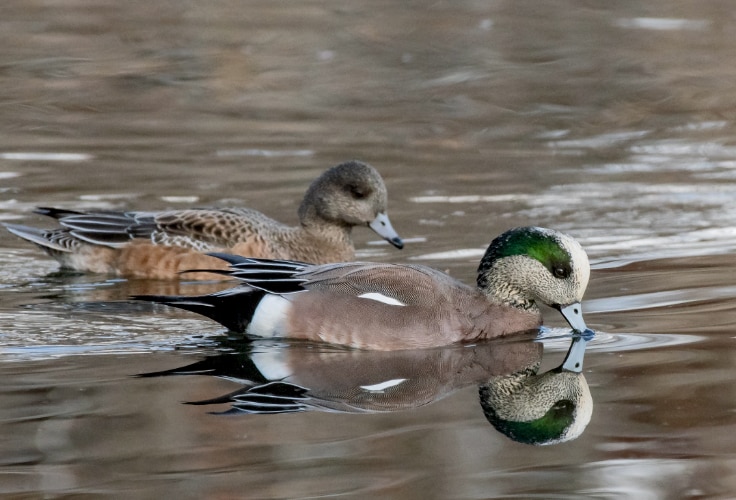
In the field, wigeon are active grazers, frequently seen walking on land or plucking vegetation in fields. They also dabble and tip-up for submerged plants, and during breeding add insects and other invertebrates to the diet. Their takeoff is nearly vertical, followed by quick and erratic flight. The male’s high-pitched “whew-whew-whew” whistle is a key recognition cue, contrasting with the female’s guttural calls.
The species breeds widely across Alaska, the Yukon, and western and northern Canada, south through the Prairie Pothole Region into the northern United States, with scattered nesting farther east to the Great Lakes and Atlantic Canada. In winter, birds concentrate in California’s Central Valley, coastal Texas, and Louisiana marshes, with smaller numbers along the Atlantic Coast and south through Mexico, the Caribbean, and Central America. Nests are usually hidden in grass or brush on dry ground near wetlands.
American wigeon remain common but have shown declines in some areas, particularly in the Prairie Pothole Region during drought years. Fluctuations reflect changing wetland availability and agricultural land use. Main threats include habitat loss and degradation, as well as reduced nesting cover. Conservation programs focused on prairie wetlands and wintering grounds, along with regulated harvest, help sustain populations across the continent.
Northern Pintail
Anas acuta
- Identification: Large, elegant duck with very long neck and pointed tail; males show chocolate-brown head, clean white breast with narrow white neck stripe, and gray body; females finely mottled brown.
- Where found: Breeds widely across Alaska, Canada, and parts of the northern United States; winters along Pacific, Gulf, and Atlantic coasts and inland valleys and reservoirs south into Mexico and Central America.
- How to spot: Look for the slim profile, long neck, and sharply pointed tail held up on the water; fast, agile flight with steep takeoffs; males give thin whistles, females lower “kuk” calls.
- Conservation status: Least Concern globally; in North America long-term declining with recent concern flagged in regional assessments; threats include wetland loss, drought, and nest destruction.
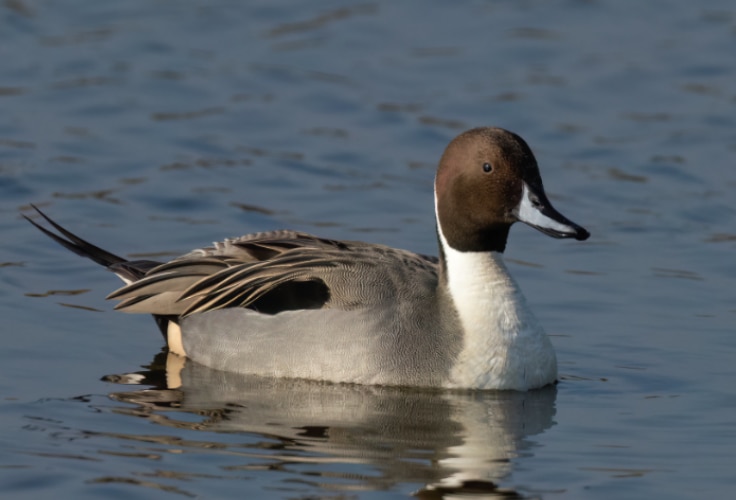
The northern pintail is among North America’s most graceful dabblers – slender, long-necked, and unmistakably “tailed.” Adults measure 50 to 76 centimeters (19.7 to 29.9 inches) in length, with up to 10 centimeters (3.9 inches) contributed by the elongated central tail feathers. The species’ slim body, narrow neck, and pointed tail give it a distinctive silhouette in any flock of ducks.
Males in breeding plumage show a rich chocolate-brown head, crisp white breast, and a narrow white stripe that climbs up the neck into the side of the head. The body is mostly gray and finely vermiculated, the scapulars and tertials long and neatly striped, and the speculum metallic green to bronze with a broad white trailing edge. Females are finely mottled gray-brown with paler underparts and a duller bronze-brown speculum with a white trailing edge. Eclipse males resemble females but usually keep longer gray tertials and a well-marked speculum; juveniles are browner with shorter, plainer tertials and a reduced white trailing edge.
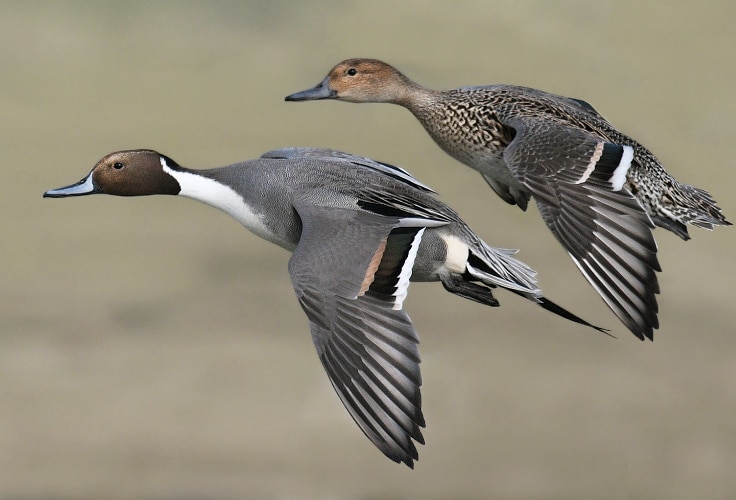
In the field, pintails ride high on the water with the tail tipped up, feed by dabbling and tipping up, and readily forage in shallow fields. They are agile fliers, lifting almost straight up and wheeling on slender wings; pursuit flights can be fast and acrobatic. Males give thin whistles and wheezy notes, including display calls; females produce low “ke/kuk” calls and rapid “kak” series when excited. Diet is diverse and seasonally flexible: grains and seeds (often in harvested fields), tubers and rhizomes, pondweeds, and aquatic invertebrates; birds sometimes make brief shallow dives to reach bottom seeds.
Across North America, pintails breed from Alaska and the Yukon through much of boreal Canada and south into the Prairie Pothole Region, Great Basin, and locally into northern portions of the contiguous United States. Ground nests are typically in open grass or low cover, often some distance from water, and may occur in recently burned areas or agricultural landscapes. In winter they concentrate in distinct regions: the Pacific Northwest and California’s Central Valley, Gulf Coast and Texas rice country, coastal Mexico and interior basins, and to a lesser extent the Atlantic Coast. They also use inland reservoirs, bays, saline lagoons, and flooded fields wherever shallow water persists.
Abundance has fluctuated with wet-dry cycles, but the long-term regional trend is downward, linked to loss and fragmentation of prairie wetlands, cultivation of grasslands, and nest loss in croplands; drought years depress numbers, with partial rebounds in wetter periods. Regulated harvest, large-scale wetland restoration, and work with farmers to reduce nest destruction are central management approaches. Despite broad distribution, sustained habitat conservation is pivotal to reverse declines across the continent.
Wood Duck
Aix sponsa
- Identification: Medium-sized duck with crested head and broad tail; males strikingly multi-colored with iridescent green, purple, and chestnut, females gray-brown with bold white eyering and throat patch.
- Where found: Breeds across much of eastern North America, Pacific Coast states, and locally inland; winters in the southeastern U.S., California’s Central Valley, Gulf Coast, Mexico, and Cuba.
- How to spot: Look for the crested head, long tail, and in males the ornate plumage; females show a teardrop-shaped white eyering. Often perches in trees or flushes quickly with loud calls.
- Conservation status: Least Concern globally; populations increasing after past declines, aided by nest box programs, but still threatened by hunting and cavity-tree loss.

The wood duck is one of North America’s most colorful birds, and often considered the continent’s most ornate duck. Adults measure 47 to 54 centimeters (18.5 to 21.3 inches) in length, with a crested head, broad wings, and a rectangular tail. They are unusual among ducks for their strong affinity with wooded wetlands and for their frequent use of perches and cavities.
Males in breeding plumage are unmistakable: a glossy green and purple head with a long crest, bold white stripes on the face and throat, a red eye, burgundy breast, and patterned flanks. Females are more subdued, gray-brown overall with a distinct white throat, a bold white eyering that extends behind the eye, and a gray crest. Juveniles and eclipse males resemble females but are duller, with less distinct markings. The species is sometimes confused with the exotic mandarin duck, but the latter shows different head and cheek patterns.
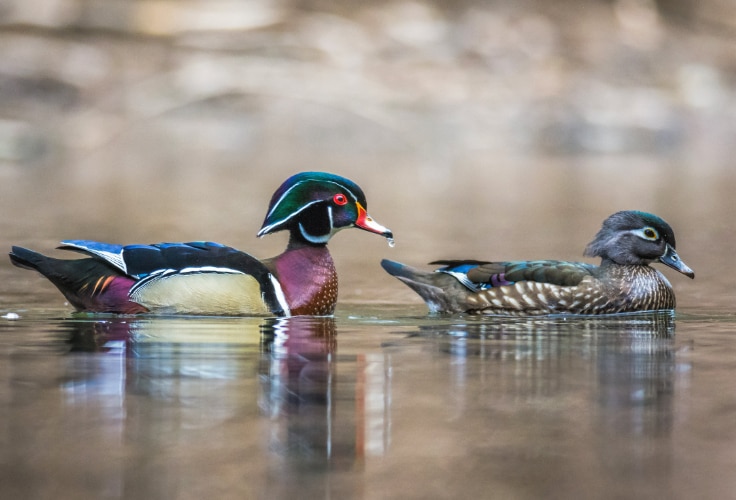
In the field, wood ducks stand out for their crests, quick flight through forested wetlands, and tendency to perch on branches. They flush rapidly with a loud screeching whistle. On the water, they swim buoyantly, dabble for seeds and invertebrates, and sometimes dive shallowly for acorns. Their diet includes acorns, fruits, seeds, aquatic plants, and invertebrates, and they have an unusual ability to swallow large acorns whole. Pairs form on wintering grounds, with courtship involving whistles, head tilts, and ritualized preening.
The species breeds widely across eastern North America, from southern Canada to Florida and west into the Dakotas and Texas. It also breeds along the Pacific Coast from British Columbia south into California, and locally inland into the Rockies and Great Basin. Nests are placed in natural tree cavities or, increasingly, in nest boxes, often near wooded swamps, rivers, or ponds. Wintering occurs mainly in the southeastern U.S., Gulf Coast, Mississippi Alluvial Valley, California’s Central Valley, Mexico, and Cuba, with local residency where winters are mild.
Wood duck populations crashed in the late 19th century from overhunting and logging of bottomland forests, but careful protection and nest box programs allowed strong recovery. Today, they are considered secure and even increasing, though they remain heavily hunted, second only to mallards in harvest. Their reliance on cavity trees makes them sensitive to forestry practices, but the widespread installation of predator-resistant nest boxes has greatly boosted breeding success. The species is now a conservation success story and a familiar sight in wooded wetlands across its range.
Bufflehead
Bucephala albeola
- Identification: Small duck with a large rounded head and short gray bill; males striking black-and-white with head gloss and large white patch, females brownish with white cheek patch.
- Where found: Breeds mainly in boreal forests and aspen parklands of Canada and Alaska; winters along both U.S. coasts, inland lakes, and reservoirs.
- How to spot: Look for the compact size, buoyant dive, and in males the bold white head patch; females show a white ear patch and smaller wing patch.
- Conservation status: Least Concern globally; populations stable or increasing, though threatened locally by habitat loss and hunting pressure.
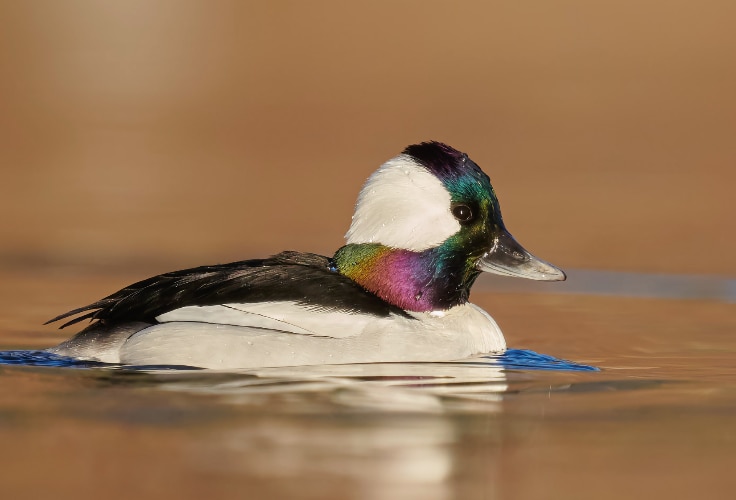
The bufflehead is North America’s smallest diving duck and a familiar winter visitor to sheltered bays and lakes. Adults measure 32 to 40 centimeters (12.6 to 15.7 inches) in length, with a compact body, short neck, and small gray bill. Their cavity-nesting habit and strong fidelity to mates make them unique among ducks on the continent.
Adult males in breeding plumage are unmistakable, with a glossy black head showing green and purple iridescence and a large white patch wrapping from the ear coverts across the nape. Their body is mostly white with a black back and wings marked by a bold white wing patch. Females are dark brown above with pale gray underparts, a neat white cheek patch, and a smaller white wing patch. Males in eclipse plumage resemble females but usually retain larger white patches on face and wings. Juveniles are also brownish, closely resembling females.
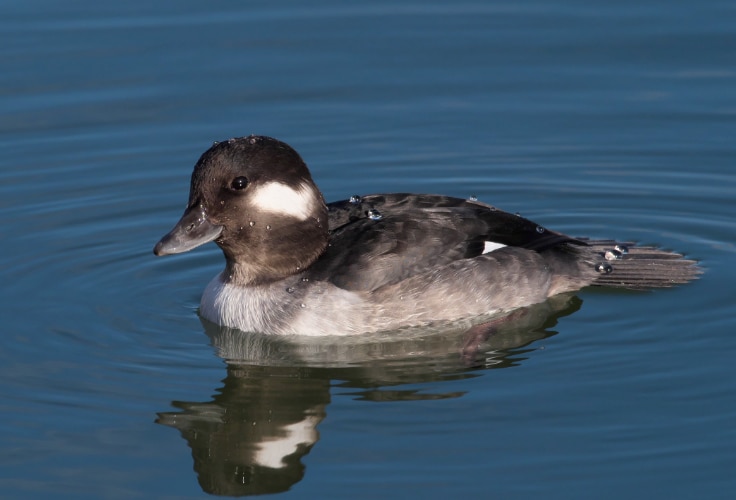
In the field, buffleheads are recognized by their diminutive size, buoyant swimming, and active diving. They take flight quickly by running a short distance on the water and fly low over lakes or coastlines. Their dives are fast and direct, with birds often bobbing to the surface like corks. Flocks are usually small, and the species is often seen loosely associating with goldeneyes but appears notably smaller. Males give grating or squealing calls during courtship displays, while females use rapid guttural calls to communicate with mates or young. They feed exclusively by diving, taking aquatic insects, crustaceans, mollusks, and some plant seeds.
Breeding occurs mainly in boreal forest regions of western and central Canada, Alaska, and locally into the northern United States. Nesting depends heavily on tree cavities, particularly those excavated by northern flickers and other woodpeckers, usually near small, fishless ponds. Isolated breeding also occurs in the northern Rockies and locally in the Pacific Northwest and California. In winter, buffleheads concentrate along sheltered coastal waters of both the Pacific and Atlantic, favoring estuaries, coves, and bays, while smaller numbers occur inland on lakes, rivers, and reservoirs.
Populations of buffleheads are stable and have increased in recent decades after recovering from early twentieth-century overshooting. Conservation concerns include the loss of cavity-nesting habitat due to logging and the clearing of aspen parklands, as well as hunting pressure in wintering areas. However, regulated harvest and the provision of nest boxes have supported their populations. Overall, this small, energetic diver remains common and secure across its range.
Ring-Necked Duck
Aythya collaris
- Identification: Small to medium duck with peaked head profile; males black with gray flanks and white bill bands, females brown with pale face, white eyering, and gray bill.
- Where found: Breeds across Canada, Alaska, and the northern U.S.; winters through much of the southern U.S., Mexico, Central America, and the Caribbean.
- How to spot: Look for the peaked head shape, male’s white spur on the sides, and white ring near the bill tip; flight shows dark upperwings without white stripe.
- Conservation status: Least Concern globally; populations increasing, though still vulnerable to wetland loss and lead ingestion.
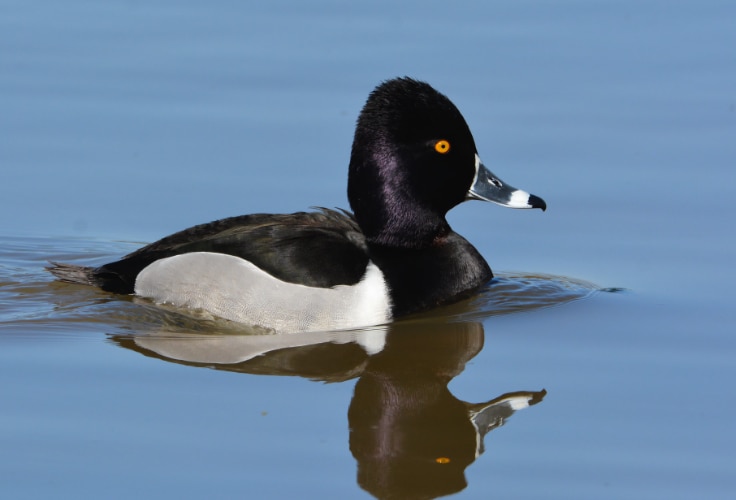
The ring-necked duck is a widespread diving duck, notable for its sharply peaked crown and strong continental population growth since the 1970s. Adults are relatively small, measuring 39 to 46 centimeters (15.4 to 18.1 inches) in length, and show a slender, angular profile with a somewhat longer tail than most related species.
Adult males in breeding plumage are striking, with a glossy black head, breast, back, and rump contrasting with gray sides and whitish belly. A bright triangular white wedge marks the side in front of the folded wing. Their bill is slate gray with a bold white base ring, narrow white subterminal band, and black tip. Females are brown overall with darker crown, paler face, white eyering, and subtle white line extending back from the eye. The bill is gray with a faint white band near the tip. Juveniles resemble females, while eclipse males appear female-like but keep traces of the bill pattern and darker body.
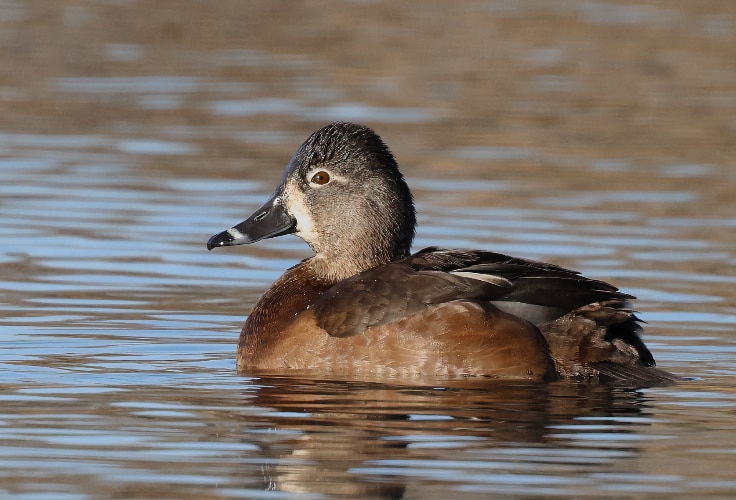
In the field, ring-necked ducks are best identified by their angular head shape and white bill markings. Males also show a bright white spur on the sides, visible at rest and in flight. Their flight is fast and sometimes erratic, with compact flocks wheeling in tight wedges. They dive actively, using only their feet for propulsion, and surface with seeds, tubers, or aquatic invertebrates. They also snap at insects on the water surface or graze on low vegetation. Males give short whistles and cough-like notes during display, while females utter soft growls and alarm calls around the nest and brood.
The species breeds widely across boreal and forested wetlands of Canada, Alaska, and the northern United States, with concentrations in central Canada, Minnesota, Wisconsin, Michigan, and the Northeast. Breeding occurs in shallow marshes, bogs, and fens with abundant sedges and floating vegetation. In winter, ring-necked ducks are most numerous in inland freshwater habitats across the southern United States, extending south through Mexico, the Caribbean, and locally to Central America. Nests are typically built over water within dense emergent cover such as sedges or cattails.
Ring-necked ducks are currently abundant, with populations steadily increasing over the past five decades. They remain sensitive to wetland drainage, degradation, and disturbance during both breeding and migration. Ingestion of old lead shot, though reduced since the 1991 ban on lead ammunition for waterfowl hunting, continues to pose risks. Conservation efforts focusing on wetland protection and sustainable harvest have supported the species’ expansion, making it a common sight across much of North America.
Lesser Scaup
Aythya affinis
- Identification: Medium-sized duck; males black-headed with gray back and whitish sides, females brown with white patch at bill base; both with peaked crown and yellow eyes.
- Where found: Breeds across Alaska, Canada, and the northern United States; winters mainly along the Gulf Coast, southern U.S., Mexico, the Caribbean, and locally to northern South America.
- How to spot: Look for the peaked head shape, male’s fine gray back barring and white flanks, and female’s bold white bill patch; flight shows a narrower white wing stripe than greater scaup.
- Conservation status: Least Concern globally; populations stable in recent years, with threats tied to habitat change and pollution.

The lesser scaup is the most abundant diving duck in North America, recognized for its gregarious flocks and subtle differences from the closely related greater scaup. Adults are 38 to 46 centimeters (15.0 to 18.1 inches) long, with a compact body, relatively small bill, and peaked rear crown that helps separate them from their round-headed cousin.
Adult males in breeding plumage have a glossy black head with green or purple iridescence, black breast and rump, finely barred gray back, and bright white sides. Their bill is bluish-gray with a black nail at the tip, and their iris shines yellow. Females are chocolate brown with darker crown, paler face, and a distinct white patch at the base of the bill. Immatures resemble females but duller, and eclipse males resemble females while retaining some white on the sides.
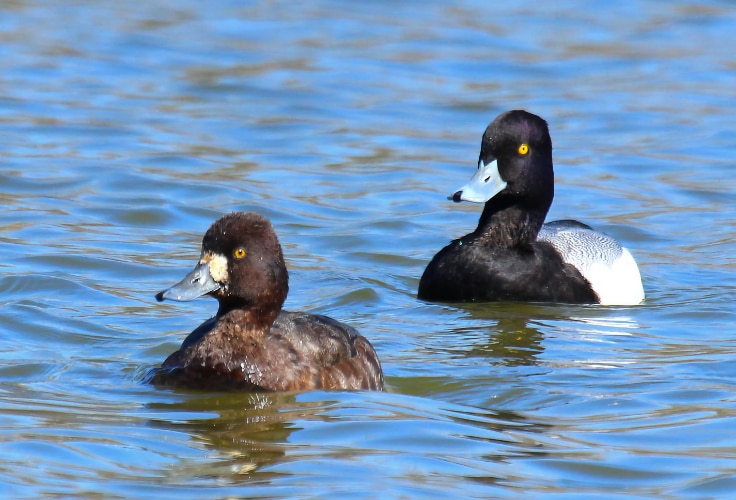
In the field, lesser scaup can be distinguished from greater scaup by their smaller size, peaked head, narrower bill, and less extensive white wing stripe. They dive frequently, surfacing with mollusks, crustaceans, aquatic insects, and seeds, and often handle larger prey at the surface before swallowing. Their flight is swift and maneuverable with rapid wingbeats, and they gather in compact flocks that may number into the thousands during migration or winter. Courtship displays include wing flicking, tail wagging, and exaggerated head throws, while females respond with chin lifts and calls.
The species breeds widely across the boreal forests, parklands, and prairie potholes of Alaska, Canada, and the northern United States, with highest concentrations in central Canada and the northern prairies. Nests are usually placed in tall grass or sedge cover, sometimes on floating vegetation. In winter, lesser scaup concentrate in massive flocks along the Gulf Coast of Louisiana and Florida, on Mexico’s coastal lagoons, and in inland lakes and reservoirs. Smaller numbers occur along the Pacific Coast, the Great Lakes, the Atlantic Coast, and south into the Caribbean and northern South America.
Lesser scaup remain common but experienced population declines in the late 20th century, leading to concern among waterfowl managers. Numbers now appear more stable, though still below historical levels. Threats include habitat loss in breeding and migration areas, pollution and contaminants in wetlands, and ingestion of lead shot or spent ammunition. Conservation programs protecting prairie wetlands and regulating hunting have been important in sustaining populations, but continued monitoring is needed to ensure long-term stability.
Redhead
Aythya americana
- Identification: Medium-sized duck; male shows rich rufous head, black breast, gray body, blue-gray bill with white band; female plain brown with pale chin and eye-ring, and rounded head.
- Where found: Breeds in the Prairie Pothole Region and western North America with scattered populations farther east; winters mainly along the Gulf Coast, southern U.S., and Mexico.
- How to spot: Note the evenly rounded head and shorter, less sloping bill than canvasback; males’ rufous heads stand out, and winter birds often form very large rafts on coastal bays.
- Conservation status: Least Concern globally; populations broadly stable but with regional declines, pressured by wetland loss, drought, and disturbance on breeding and wintering sites.
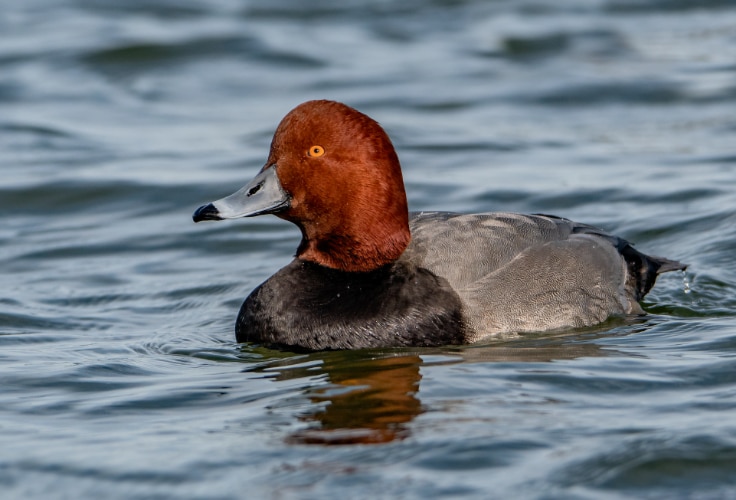
The redhead is a hallmark diving duck of North America, famed for immense winter rafts on the Gulf Coast and Laguna Madre. Adults measure 42 to 54 centimeters (16.5 to 21.3 inches) in length. The species has a compact body, evenly rounded, high-arched head, and a shorter, less sloping bill than Canvasback – useful structural cues at any distance.
Adult males in breeding plumage show a rufous head and neck, black breast, gray body, and black hindquarters, with a yellow eye and a blue-gray bill tipped black with a white subterminal band. Females are plain brown overall with a paler chin and a neat eye-ring; the bill pattern is similar but subtler. Males pass briefly through an eclipse phase resembling females but retain a yellow eye and dull reddish head. From a distance, male heads can look dark; at closer range the rich rufous is obvious.

In the field, separate redhead from canvasback by the rounder, “puffy” head and shorter, less triangular bill; canvasback shows a longer sloping profile and paler body. Redheads dive vertically after a slight forward leap, using their feet for propulsion, and adjust tactics to water depth – diving, tipping, or dipping as needed. Diet shifts with season: in marshes they take tubers, seeds, and invertebrates; on coastal wintering grounds they rely heavily on seagrasses and also take mollusks. Males give a distinctive wheezy “whee-ough” or catlike “meow” during display; females utter soft “err” and deeper “kurr” notes, including around nests and broods.
Redheads breed primarily in the Prairie Pothole Region of southern Canada and the northern United States, with strongholds in Alberta, Saskatchewan, Manitoba, the Dakotas, and Montana. Additional breeding occurs across western regions from British Columbia and the Great Basin to scattered pockets in the Great Lakes and Atlantic Canada. In winter they shift southward, concentrating in massive rafts along the Gulf Coast, especially in Texas and Louisiana, and in the Laguna Madre of Mexico. Smaller numbers winter inland on large lakes and reservoirs or along the Atlantic and Pacific coasts. Nests are built over water in dense emergent vegetation, commonly in bulrush or cattail stands.
Overall numbers have been broadly stable in recent decades, though some regions, such as the Great Basin and parts of the interior West, have seen declines. Key pressures include drainage and degradation of prairie wetlands, drought limiting breeding habitat, and disturbance at nesting and wintering sites. Protection and restoration of prairie wetlands and shallow coastal seagrass habitats, along with regulated harvest and management on major wintering areas, continue to support the species across North America.
Greater Scaup
Aythya marila
- Identification: Medium-sized, round-headed duck; males show black head with greenish gloss, black breast, gray back, clean white sides, and a broad white wing stripe; females brown with a distinct white patch at the bill base.
- Where found: Breeds mainly in Alaska and scattered high-latitude Canada east to Ungava and Newfoundland; winters chiefly on Atlantic and Pacific coasts and locally on the Great Lakes.
- How to spot: Look for the smoothly rounded head, larger and broader bill, and the white wing stripe that extends well into the primaries; males show golden-yellow eyes and green sheen in good light.
- Conservation status: Least Concern globally; nevertheless showing long-term declines, with concerns tied to warming waters, disturbance, and habitat degradation.

The greater scaup is North America’s more marine-oriented scaup and the bulkier member of the scaup pair. Adults measure 39 to 56 centimeters (15.4 to 22.0 inches) in length. A smoothly rounded head, broad bill, and robust body help separate it from Lesser Scaup, which tends to show a peaked hindcrown.
Males in breeding plumage have a black head and neck with a greenish gloss, black breast and rear, finely vermiculated gray back, and crisp white sides. The broad white wing stripe spans the secondaries and extends well into the primaries. Eyes are golden-yellow. Females are brown overall with paler flanks and a clear white patch at the base and sides of the bill; their backs often show faint whitish vermiculations. Eclipse males resemble duller versions of breeding males, and juveniles look like females but are plainer.
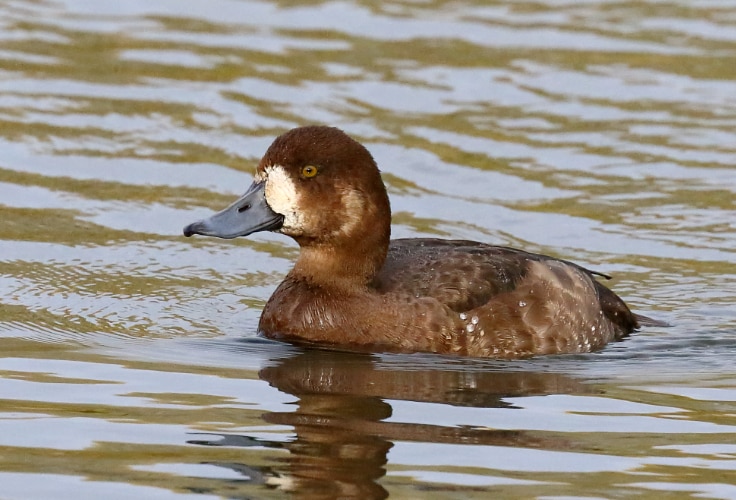
In the field, shape and wing pattern are decisive. The greater scaup shows a smoothly rounded head, fuller “cheek,” and a more extensive white wing stripe than the lesser scaup. Flocks fly fast and low, twisting and shifting like smoke over open water. On the water they dive repeatedly, often in tight rafts, to take benthic prey; they can reach notable depths and rise buoyantly. Males give soft whistles during displays; females utter harsh rasping notes when alarmed. Diet is flexible but leans on small bivalves, snails, crustaceans, insect larvae, and seeds and other plant matter, shifting with season and site.
Breeding occurs mainly across coastal tundra wetlands from the Aleutians and western Alaska east in scattered pockets across far-northern Canada to the Ungava region and Newfoundland. Nests are well concealed in tall sedges or grasses on solid or floating substrates near shallow lakes, pools, and slow rivers. During winter, large numbers concentrate on marine waters: Long Island Sound to New Jersey, parts of New England and the Canadian Maritimes, and on the Pacific from the Aleutians to northern California, with additional concentrations on the Great Lakes when ice conditions allow.
Although still widespread, the species has declined over recent decades. Multiple stressors likely interact: warming water regimes in Alaska, contaminants and heavy metals in urbanized coastal wintering areas, disturbance and habitat degradation on bays and estuaries, and additive effects of regulated harvest. Continued monitoring and protection of key coastal and lake habitats are important to stabilize this emblematic diving duck.
Common Goldeneye
Bucephala clangula
- Identification: Medium-sized diving duck with males showing black head and white oval face patch; females gray-bodied with chocolate-brown head; both sexes with bright yellow eyes.
- Where found: Breeds across boreal forests of Canada and Alaska; winters widely on both coasts, Great Lakes, major rivers, and inland lakes as far south as Mexico.
- How to spot: Look for the compact shape, bright golden eyes, and in flight the rapid wingbeats that produce a loud whistling sound.
- Conservation status: Least Concern globally; populations stable in North America, though threatened locally by forestry practices and wetland degradation.

The common goldeneye is a widespread and hardy diving duck, often called the “whistler” for the sound of its wings in flight. Adults measure 40 to 51 centimeters (15.7 to 20.1 inches) in length, with a chunky body, short neck, and small gray-black bill. Their speed and agility on water and in the air make them one of the most distinctive winter ducks across the continent.
Adult males in breeding plumage have an iridescent black head with a bright white oval spot at the base of the bill, a mostly white body, and black back and tail. Females are slaty gray with a chocolate-brown head, white belly and breast, and a mostly dark bill tipped with yellow. Both sexes have piercing golden-yellow eyes that stand out in the field. Juveniles and eclipse males resemble females, though their eye color is duller. The species closely resembles Barrow’s goldeneye, but can be told by its oval face patch, more sloping bill, and peaked crown shape.

In the field, goldeneyes are recognized by their fast, direct flight and distinctive wing whistle, audible up to a kilometer (0.6 miles) away. They take off with only a short run on the water and often fly in small, tight groups. On the water, they dive frequently, sometimes in synchrony with flockmates, holding wings close and propelling with their feet. Dives may last up to a minute. Courtship begins in winter flocks, with males performing elaborate head-throws and display calls. Their diet consists mainly of aquatic invertebrates such as insects, crustaceans, and mollusks, with small fish and plant matter taken occasionally.
Goldeneyes breed widely across boreal forests of Canada and Alaska, nesting in tree cavities made by large woodpeckers or formed by rot. They may also use nest boxes when available, sometimes at considerable distances from water. In North America, breeding extends south into the northern United States, including New England, the Great Lakes region, the northern Rockies, and montane forests. Wintering birds are abundant along both the Atlantic and Pacific coasts, in the Great Lakes, and on major rivers, lakes, and reservoirs as far south as central Mexico and Florida. They favor coastal bays, estuaries, and inland waters that remain ice-free.
Populations are considered stable, with millions present globally. They are heavily hunted but remain secure under regulated harvest. The main conservation concerns include the loss of cavity-nesting habitat through forestry practices that remove large, dead trees, and degradation of winter foraging areas from wetland drainage, river modification, and industrial impacts. Nest box programs and forest management practices that preserve snags have helped maintain populations. Overall, the species remains widespread and abundant across its range.
Ruddy Duck
Oxyura jamaicensis
- Identification: Small, stocky duck with a thick neck and a long, stiff, fan-shaped tail often held upright; breeding males show a sky-blue bill, white cheek, and rich chestnut body.
- Where found: Breeds chiefly in the Prairie Pothole Region of southern Canada and the north-central United States, with scattered breeding farther west and south; winters widely across the United States, Mexico, and the Caribbean.
- How to spot: Look for the cocked, spiky tail and compact profile; males in spring show a white cheek and blue bill, while females and immatures are brown with a dark cheek stripe; birds dive frequently and are seldom seen flying.
- Conservation status: Least Concern globally; North American populations broadly stable, but locally affected by wetland loss, degraded water quality, and pollution.
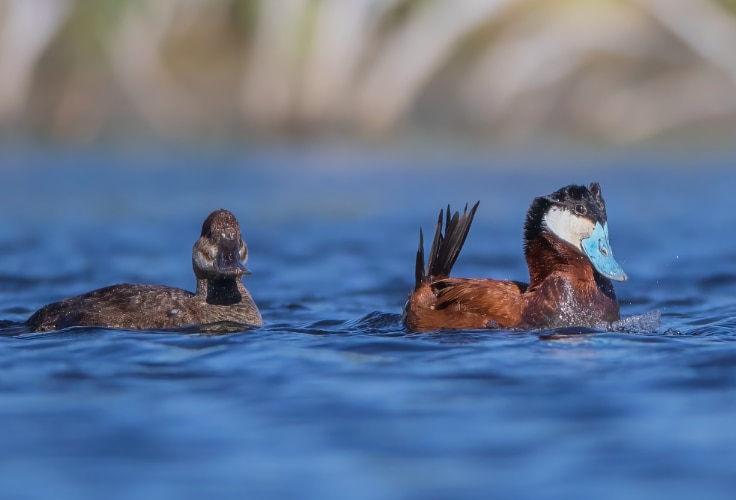
The ruddy duck is the stiff-tailed duck most often seen in North America, instantly notable for its cocked tail and low, compact posture on the water. Adults measure 35 to 43 centimeters (13.8 to 16.9 inches) in length. Short wings, large feet set far back, and a heavy body advertise a specialist diver that is built for swimming more than walking or agile flight.
Plumage is strongly seasonal in males. Breeding males show a glossy black cap and nape, bright white cheeks, a sky-blue bill, rich reddish-chestnut upperparts and flanks, and a pale silvery belly; wings are dark and lack a colored speculum. In non-breeding plumage males become brown and female-like with mottled cheeks and a dark slate bill. Females are brown overall with a dark cap and a distinct dark line through the pale cheek; immatures resemble females.
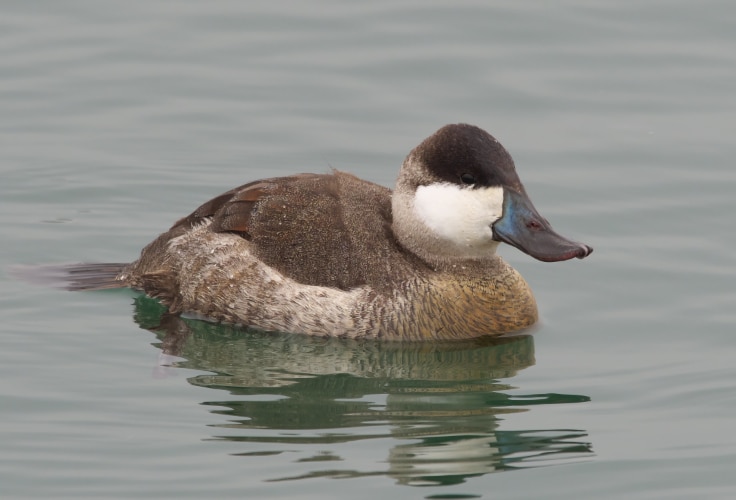
In the field, the best cues are behavior and shape: birds bob like corks in tight groups, dive repeatedly, and run a long distance over the surface to take off. Flight is swift and direct but they are rarely airborne by day on breeding ponds. Males perform striking courtship, drumming the bill on the inflated neck to make bubbles and ending with a belch-like note; females give nasal calls and hiss when threatened. They forage almost entirely by diving, taking aquatic invertebrates along with small crustaceans, zooplankton, and some plant material.
Across North America, ruddy ducks concentrate in the Prairie Pothole Region for breeding, especially in the Dakotas and southwestern Manitoba, and nest in dense emergent vegetation on marshes, stock ponds, reservoirs, and larger basins with both cover and open water. Scattered breeding occurs west into British Columbia and south into the interior West and Southwest, with local nesting farther east. In winter they spread widely across the United States and into Mexico, the Bahamas, Greater Antilles, and locally Central America, favoring large lakes, reservoirs, coastal bays, and estuaries.
The species remains common with overall stable trends, though numbers fluctuate with wetland conditions. Regional declines have followed habitat degradation and poor water quality, and like other waterfowl species they are vulnerable to pollution and oil spills. Conservation of prairie wetlands and maintenance of clean, vegetated marshes and reservoirs are central to sustaining their populations.
Common Merganser
Mergus merganser
- Identification: Large merganser with long, thin, serrated red bill; males show dark green head and mostly white body with gray back, females gray with rusty-brown crested head and a sharply defined white chin patch.
- Where found: Breeds widely across boreal Canada and Alaska and south into northern U.S. forests and mountains; winters wherever large lakes and rivers remain ice-free across southern Canada and the United States.
- How to spot: Look for the long, sleek profile riding low on the water, fast direct flight with shallow wing arc, and frequent synchronized diving.
- Conservation status: Least Concern globally; North American trend generally stable, with local threats from contaminants and acidification, and wetland degradation.
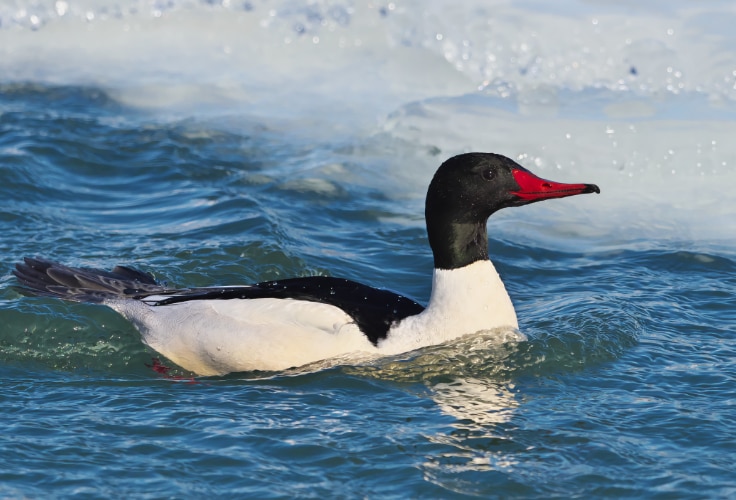
The common merganser is North America’s big, fish-eating “sawbill,” a powerful diver of clear rivers and lakes. Adults measure 54 to 71 centimeters (21.3 to 28.0 inches) in length. A long, sleek body, thick neck, and narrow, hooked, serrated bill give it a distinctive predatory look among waterfowl.
Males in breeding plumage have a dark, greenish-black head without a crest, brilliant white neck and underparts with a subtle peach blush, black upperwings, gray back and tail, and a bright scarlet-orange bill. Females are gray above with white flanks and belly, a rich rusty-brown head with a swept-back crest, and a crisp white throat patch that is sharply demarcated from the pale lower neck. Juveniles resemble females, with paler heads and shorter crests. From the similar red-breasted merganser, look for the common’s larger, bulkier build, thicker bill, clean white throat, and the male’s uncrested head and whiter body.
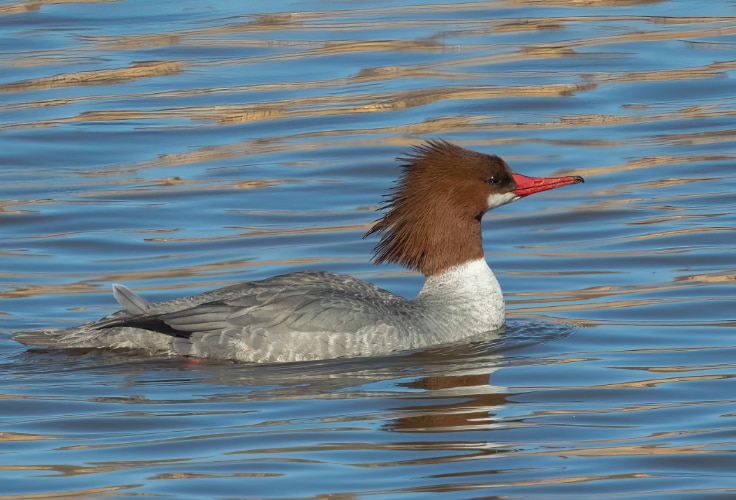
On the water, common mergansers sit low and often travel in loose lines along shorelines, dipping the head to scan before making frequent, easy dives. Groups may dive in rapid “follow-the-leader” sequence. Flight is fast and direct, with shallow wingbeats and steep takeoffs; birds usually patter across the surface before lifting. Vocalizations are limited and mostly tied to courtship; flocks can be quiet even at close range. Diet is dominated by small fish, supplemented by aquatic invertebrates, frogs, and occasional other prey, all captured by pursuit diving with the feet providing propulsion.
The species breeds across the northern forests of North America, from Alaska and much of Canada south into the northern United States where mature trees near rivers and lakes provide suitable nesting cavities. In winter they remain as far north as open water is available, gathering on large rivers, lakes, and reservoirs. They are widespread across the southern half of Canada and the United States in this season, extending locally into northern Mexico, and are also found in sheltered coastal bays and estuaries, though they use salt water less frequently than red-breasted mergansers.
Populations in North America are broadly stable. As top aquatic predators, common mergansers are sensitive to contaminants, heavy metals, and acidification, which can degrade habitat, thin eggshells, and reduce prey. They’re taken occasionally by hunters and have sometimes been persecuted due to concerns over trout and salmon, though such actions are regulated. Because they respond to water quality, the species is often treated as an indicator of freshwater ecosystem health, and protection of clean, fish-rich rivers and cavity-bearing forests remains central to its conservation.
Hooded Merganser
Lophodytes cucullatus
- Identification: Compact merganser with thin serrated bill; males striking with bold black-and-white crest and chestnut flanks, females brown with shaggy crest and yellowish bill.
- Where found: Breeds in wooded wetlands across eastern North America, the Great Lakes, and Pacific Northwest; winters widely across the southern U.S. north to open water.
- How to spot: Look for the male’s dramatic fan-shaped crest or the female’s bushy brown head; swims low, dives often, and takes off with fast wingbeats and no gliding.
- Conservation status: Least Concern globally; populations increasing steadily, supported by reduced hunting and widespread use of nest boxes.

The hooded merganser is North America’s smallest merganser, easily recognized by its compact form and bold crest. Adults measure 40 to 49 centimeters (15.7 to 19.3 inches) in length, with a narrow, serrated bill adapted for gripping fish and invertebrates. Their striking appearance and specialized foraging make them one of the most distinctive forest-dwelling ducks.
Males in breeding plumage are unmistakable, with a glossy black head, white fan-shaped crest edged in black, white breast marked by bold black stripes, and rich cinnamon flanks. Females are brown overall with a shaggy, grayish-brown crest and a partly yellow bill. Immature males resemble females but usually show darker bills and some black feathering on the head. In eclipse plumage, males also resemble females but retain a yellow iris.
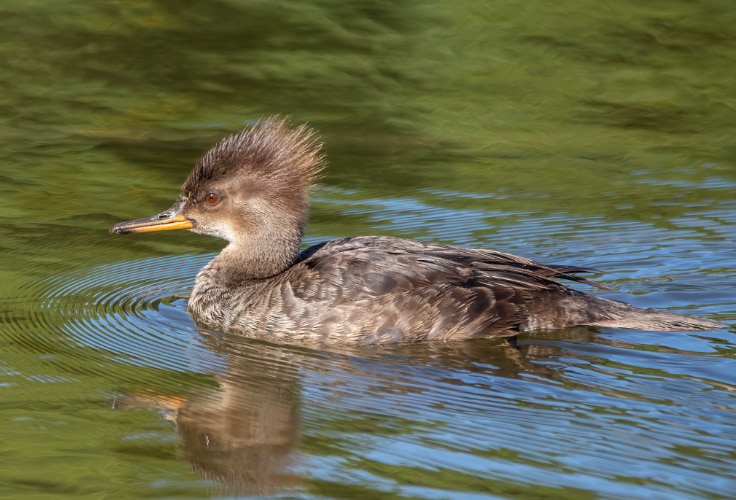
In the field, hooded mergansers swim low in the water, dive frequently, and fly with rapid, continuous wingbeats that produce a soft whirring sound. They rarely glide except when landing, skidding across the water with feet extended. Courtship displays are elaborate: males raise and spread their crests, shake their heads, and perform “head-throwing” displays while giving a rolling frog-like call. Females answer with hoarse gack calls and head-bobbing. They feed mainly on small fish, aquatic insects, and crustaceans such as crayfish, diving in clear shallow water and using excellent underwater vision to locate prey.
Hooded mergansers breed in forested wetlands and riparian zones across much of eastern North America, the Great Lakes, and the Pacific Northwest, nesting in natural tree cavities or artificial nest boxes. They are especially tied to wooded swamps, ponds, and slow-moving rivers. Wintering birds occur widely across the southern United States, from the Atlantic Coast to California’s Central Valley, and into northern Mexico and the Caribbean where waters remain unfrozen. Unlike other mergansers, they avoid open ocean, preferring sheltered freshwater and brackish habitats such as ponds, tidal creeks, and estuaries.
Once reduced by hunting and forest clearing, hooded mergansers have rebounded strongly in the twentieth and twenty-first centuries. Populations are now increasing, aided by reduced hunting pressure, the retention of dead trees in forests, and the widespread installation of nest boxes. They remain heavily dependent on cavity availability, but conservation programs in regions such as Missouri, Maine, and Oregon have boosted numbers. Today, the species is considered secure and is a conservation success among North America’s cavity-nesting ducks.
Red-Breasted Merganser
Mergus serrator
- Identification: Long, slim merganser with thin red bill and shaggy crest; males show dark green head, reddish-brown breast, gray flanks, and bold white wing patches; females gray-bodied with brown, crested head.
- Where found: Breeds mainly across coastal Alaska and northern Canada, locally in the Great Lakes and northern New England; winters chiefly along both North American coasts and on the Great Lakes.
- How to spot: Look for the slimmer shape, thinner bill, and shaggier crest than common merganser; very fast flight after a running takeoff, and frequent group diving on bays and estuaries.
- Conservation status: Least Concern globally; populations generally stable; occasional local conflicts around salmonids.
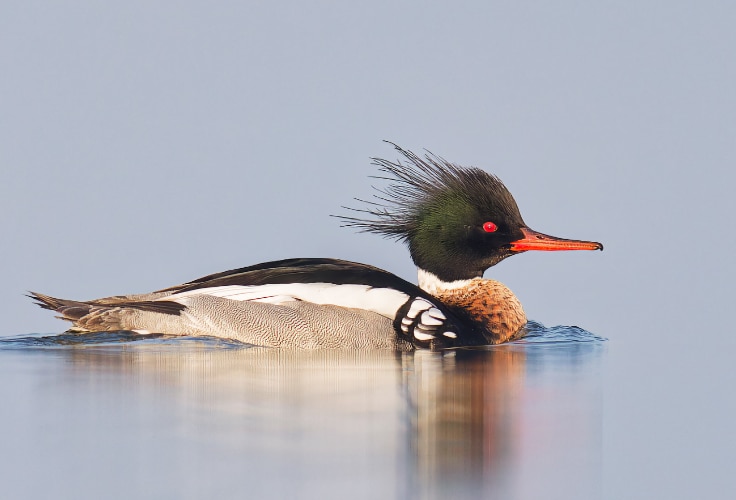
The red-breasted merganser is the most marine of North America’s mergansers and among the fastest-flying ducks. Adults measure 51 to 64 centimeters (20.1 to 25.2 inches) in length. A long, narrow body, thin serrated red bill with a hooked tip, and shaggy crest give it a sleek, sea-duck look compared with the bulkier common merganser.
Males in breeding plumage have a dark, metallic green head with a long, ragged double-pointed crest, a crisp white collar, and a reddish-brown breast speckled black; the back is black, the sides and flanks gray, and the inner wing shows broad white patches. Females are gray-brown overall with a brown crested head and whitish throat, the plumage similar year-round. Eclipse males resemble females but usually show more extensive white in the inner forewing and darker crown; immatures look like females. From common merganser, note the thinner bill, slimmer neck and body, shaggier crest, gray (not white) flanks in males, and the male’s reddish breast.

In the field, red-breasted mergansers run across the surface to get airborne, then fly fast with rapid wingbeats (often after a long takeoff run). On the water they forage by repeated dives, sometimes cooperatively herding small fish; flocks may dive in near-unison. They are social through most of the year. Vocalizations are usually quiet, but displaying males give a distinctive cat-like “yeow-yeow;” females give rough croaks. Diet is dominated by small fish and crustaceans, with insects and other prey taken locally, all captured by pursuit diving using the feet for propulsion.
Breeding spans northern coasts and large inland waters from Alaska across arctic and boreal Canada, with localized nesting south into the Great Lakes and parts of northern New England. They use deep lakes, large rivers, and coastal estuaries with ample fish. In winter they concentrate along marine shorelines on both oceans, from Alaska to Baja California and from Labrador south around Florida into the Gulf Coast, and also remain on the Great Lakes where open water persists, favoring estuaries, sheltered bays, harbors, and nearshore waters.
This species remains widespread and generally stable in North America. As a fish-eating sea duck, it depends on healthy coastal and estuarine ecosystems; pollution, oiling, and changes in prey availability can affect local numbers, and occasional conflicts occur where salmon smolts congregate. Overall, with broad distribution and adaptable foraging, the red-breasted merganser continues to be a common winter sight on North American coasts and the Great Lakes.
Canvasback
Aythya valisineria
- Identification: Large duck with a long, sloping wedge-shaped head and long bill; males show a reddish-brown head, black chest, and white body, females are gray-brown with a paler face and the same distinctive head profile.
- Where found: Breeds in prairie-parkland and boreal wetlands of interior Alaska and western–central Canada south to the northern United States; winters on large lakes and coastal bays across the Pacific, interior, and Atlantic coasts.
- How to spot: Look for the clean, sloping forehead that blends into a long bill; males are white-bodied with a rufous head and black chest, flight is direct with rapid wingbeats.
- Conservation status: Least Concern globally; populations fluctuate but have been broadly stable in recent decades, with vulnerability to wetland loss and degraded food resources.

The canvasback is North America’s archetypal pochard, famous for its sleek, sloping head profile and fast, powerful flight. Adults are large diving ducks, 48 to 56 centimeters (18.9 to 22.0 inches) long, with a long neck and a thin wedge-shaped head rising smoothly from the tip of the bill.
Adult males in breeding plumage show a reddish-brown head and neck, black breast, and mostly white to pale gray body with fine vermiculation, plus black undertail. Females are gray-brown overall with a paler buffy face, darker crown and nape, and a nearly black bill; both sexes share the long, sloping crown-bill profile. Males in brief eclipse resemble females but retain a duller reddish head and yellow eye; juveniles are female-like with subtler patterning.
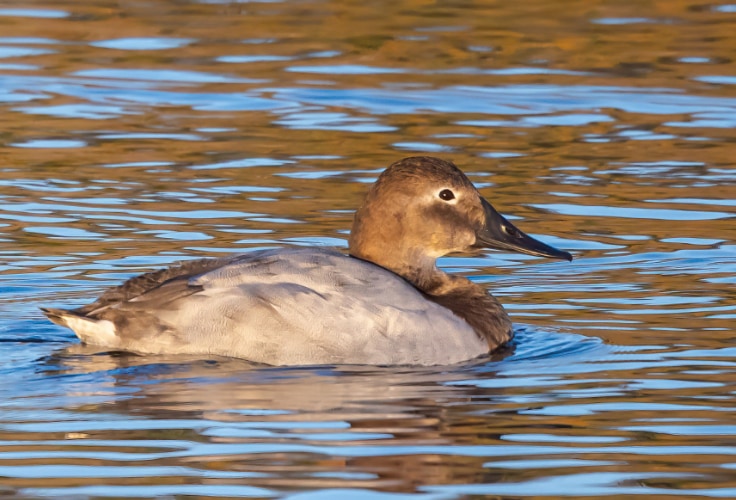
In the field, separate canvasback from redhead by shape and tone: canvasback has the longer, gently sloped head and bill and a paler body; redhead is round-headed with a shorter, less sloping bill and darker gray body. canvasbacks take a running start to lift off, then fly fast and direct with rapid wingbeats. They dive cleanly, often after a slight forward leap, and feed mainly on aquatic plants, switching to clams and snails when plant foods are scarce; during breeding they add aquatic insects and other invertebrates. Males give a soft, trisyllabic coo during displays, while females produce low, guttural notes and harsher alarms around the nest and brood.
Breeding centers in the parklands and mixed prairies of northwestern North America, extending through interior Alaska and western-central Canada south to the northern Great Plains and northern Intermountain West of the United States. They use small lakes, deep-water marshes, and sheltered bays with extensive emergent vegetation, nesting over water in cattails, bulrush, and similar cover. In winter, canvasbacks gather on major water bodies across the continent, forming very large rafts at traditional sites such as Chesapeake Bay, the Mississippi River delta, western Lake Erie, San Francisco Bay, and Puget Sound.
Population size has swung with wet-dry cycles on the prairies but has been broadly stable in recent decades. Key pressures include loss and degradation of prairie wetlands, changes in water levels that reduce nesting sites, and declines in key plant foods from pollution, siltation, and eutrophication at migration and wintering areas. Protection and restoration of wetlands and submerged aquatic vegetation, along with regulated harvest and careful management of staging and wintering sites, remain important for the species’ long-term stability.
American Black Duck
Anas rubripes
- Identification: Large, dark brown duck with a pale, streaked head, dark crown and eye-stripe, and a violet-blue wing patch usually lacking white borders.
- Where found: Breeds from eastern Canada south through the Great Lakes and mid-Atlantic states; winters along the Atlantic Coast, Great Lakes, and Gulf Coast in freshwater and tidal wetlands.
- How to spot: Look for its uniformly dark, chocolate-brown body, pale face with dark crown, and violet speculum without bold white borders; heavier-bodied and darker than mallard.
- Conservation status: Least Concern globally; populations stable in Canada but declined historically in the U.S., where hunting pressure and habitat loss remain concerns.
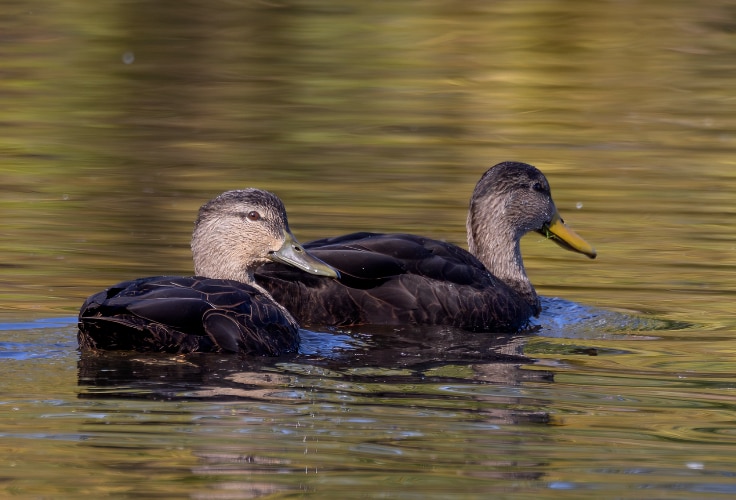
The American black duck is one of the most iconic waterfowl of eastern North America, often regarded as the wild counterpart to the familiar mallard. Adults are large dabbling ducks, measuring 54 to 59 centimeters (21.3 to 23.2 inches) in length. Their heavy build, slow wingbeats, and preference for secluded wetlands give them a distinctive presence compared to lighter, more urban-tolerant mallards.
Plumage is similar in both sexes, with a dark chocolate-brown body and paler grayish head streaked with fine lines. The crown, nape, and eye-stripe are dark, setting off the lighter face. The wings show a violet-blue speculum bordered by black and usually lacking white, a key feature distinguishing them from mallards. Males typically have yellowish to olive bills, while females’ bills are duller gray-green with darker markings. Legs and feet are reddish-orange. Juveniles resemble adults but are more heavily streaked with buff-edged feathers.
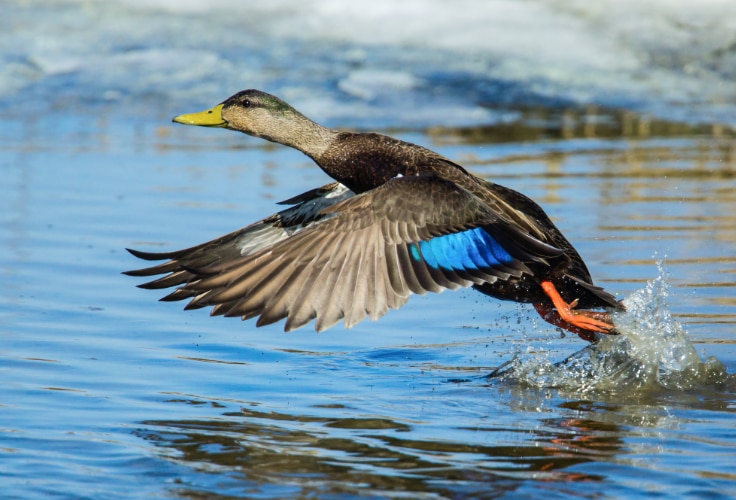
Field identification often relies on the bird’s darker, more uniform body compared to mallards and its lack of bold white in the wing patch. Their flight is slower and heavier, though they can take off nearly vertically. On the water they dabble and tip-up for food, but they are also strong swimmers and occasionally dive. Males give a reedy “raeb” call, while females produce loud quacks similar to mallards. They feed on aquatic plants, seeds, and tubers, supplemented with invertebrates, often foraging in tidal flats, marshes, and flooded fields.
The species breeds widely across eastern Canada, from Manitoba east to Newfoundland, and south into the Great Lakes, New England, and the mid-Atlantic states. Nest sites vary from coastal salt marshes and islands to wooded swamps, beaver ponds, and upland ground cover near water. During winter, American black ducks concentrate along the Atlantic Coast from New England to Florida, and also occur inland around the Great Lakes and down the Mississippi River Valley to the Gulf Coast.
Once heavily exploited by hunting and affected by habitat loss, the American black duck experienced major population declines in the 20th century. Stringent harvest restrictions and wetland protections have stabilized numbers, particularly in Canada. However, hybridization with mallards, ongoing habitat degradation, and sensitivity to pollution remain challenges. Although still considered common, the species is closely monitored as an indicator of the health of eastern North America’s wetlands.
Cinnamon Teal
Spatula cyanoptera
- Identification: Small duck with blue wing coverts in both sexes; males show rich reddish-brown plumage, females mottled brown with a plain face and longer, spatulate bill.
- Where found: Breeds mainly in wetlands of the western United States, southwestern Canada, and highlands of Mexico; winters in California, the southwestern U.S., Mexico, and Central America.
- How to spot: Look for the male’s cinnamon-red body and pale blue forewing in flight; females resemble Blue-winged Teal but have a longer, broader bill and warmer brown plumage.
- Conservation status: Least Concern globally; long-term declines; threats include wetland drainage, agricultural conversion, pollution, and hunting pressure.

The cinnamon teal is one of the most striking ducks of western North America, its male’s fiery plumage making it instantly recognizable. Adults are small dabbling ducks, measuring 36 to 43 centimeters (14.2 to 16.9 inches) in length. Their trim body and long bill give them a distinctive profile compared to other teal.
Males in breeding plumage are unmistakable: a rich reddish-brown head, breast, and underparts offset by blue upperwing coverts, a green speculum, and red eyes. Females are mottled brown with a more subdued face pattern, slightly larger and plainer than blue-winged teal females. In eclipse plumage, males resemble females but keep their reddish eyes. Juveniles also look like females, though they are paler with finer streaking.
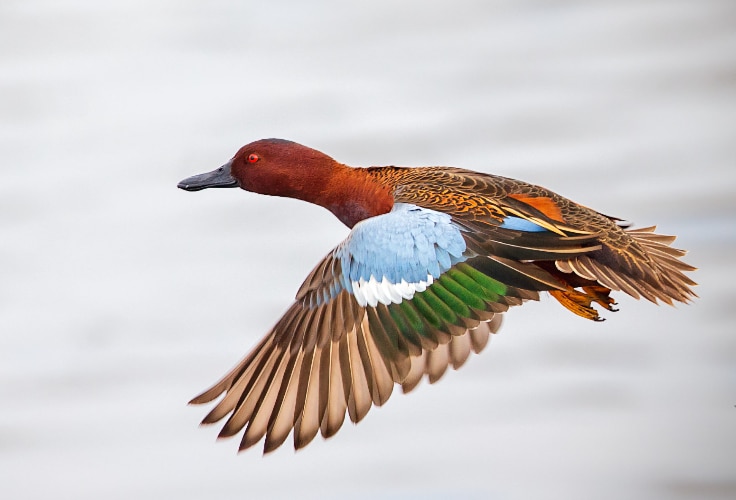
In the field, the pale blue wing patch is a reliable mark in flight. Males stand out by color, while females are best told from blue-winged teal by their longer, more spatulate bill and warmer brown tones. These ducks forage mostly by dabbling in shallow water, often in pairs or small groups, tipping up for seeds, aquatic vegetation, snails, and insects. They are quiet compared to many ducks, with males giving a low rattling call during courtship. Flight is agile, with fast wingbeats and low, twisting paths over water.
Cinnamon teal breed in the wetlands of the Great Basin, California’s Central Valley, the interior West, and locally in southwestern Canada and Mexico. They nest in dense emergent vegetation near marshes, ponds, and reservoirs, often well concealed under matted stems. After breeding, birds gather in flocks to molt before migrating. Most populations winter in California, Arizona, New Mexico, Texas, and throughout Mexico, extending south into Central America.
Although still fairly widespread, cinnamon teal populations have declined over recent decades. Wetland loss to agriculture, grazing, and urban development poses the greatest threat, along with water diversion and pollution that reduce shallow marsh habitats. They are also harvested alongside blue-winged teal, though at lower rates. Protection of prairie and western wetlands, together with careful hunting management, remains essential to sustaining this colorful species across its range.
Mottled Duck
Anas fulvigula
- Identification: Medium-sized, dark brown duck with a buffy, streaked head and eye-stripe; males have yellowish bills, females dull olive bills, both showing a bluish-green speculum usually without white borders.
- Where found: Year-round resident of Florida wetlands and coastal marshes of Louisiana and Texas, extending into northeast Mexico.
- How to spot: Look for a dark body with a creamy face and dark eye-stripe; similar to a female mallard but lacks bold white wing borders and shows a plainer, tawny throat.
- Conservation status: Least Concern globally but steeply declining; listed as a high-priority species of concern due to habitat loss, hybridization with mallards, and hunting pressure.

The mottled duck is a distinctive resident of the southeastern United States, representing one of the few North American dabbling ducks that does not migrate. Adults measure 47 to 61 centimeters (18.5 to 24.0 inches) in length, placing them close in size to mallards but slimmer in build. Unlike most ducks, their populations are confined to Florida and the western Gulf Coast, where they are a familiar breeding and year-round bird of marshes, rice fields, and coastal wetlands.
Both sexes appear mottled brown overall with buffy streaking on the head and neck and a dark crown and eye-stripe. The speculum is iridescent bluish-green, typically without white borders, distinguishing it from the mallard’s bold wing patch. Males have yellow to olive bills and brighter orange legs, while females show duller olive to orange bills often marked with blackish spots and duller legs. Juveniles are paler and slimmer, with lighter bellies and less distinct markings.

In the field, mottled ducks resemble female mallards but appear darker-bodied with a plainer face and less contrast in plumage. Their feeding behavior is classic dabbling – tipping up in shallow water for seeds, grasses, aquatic vegetation, rice, invertebrates, and small fish. They forage in pairs or small groups, sometimes forming large post-breeding flocks in rice fields. Their calls are very similar to mallards, with males giving raspy notes and females loud quacks.
This species is nonmigratory, remaining in Florida wetlands, agricultural ponds, and suburban water bodies year-round, or in Gulf Coast marshes and rice-growing areas of Louisiana and Texas. Nesting begins early in the season, often from February into summer, with nests well hidden in dense vegetation near shallow wetlands. The birds are highly responsive to local water conditions, shifting habitat use with salinity, water depth, and wetland availability.
Populations have declined steeply in recent decades due to loss of freshwater wetlands in Florida, saltwater intrusion and erosion along the Gulf Coast, and urban expansion. Hybridization with released or feral mallards is a major threat, especially in Florida, where genetic swamping could erase the pure population. Hunting adds additional pressure but is tightly regulated. Conservation strategies now emphasize wetland protection, careful management of mallard releases, and ongoing monitoring of genetic integrity.
Surf Scoter
Melanitta perspicillata
- Identification: Large, dark sea duck with a thick, swollen bill; adult males are velvety black with a white forehead patch, larger white nape patch, and a multi-colored bill, females dark brown with two pale cheek patches.
- Where found: Breeds on boreal lakes across Alaska and northern Canada; winters in large flocks along both coasts from Alaska and British Columbia to California, and from Newfoundland to the Mid-Atlantic and Florida panhandle.
- How to spot: Scan coastal flocks for males with white head patches and an orange-looking bill; birds fly low over water in tight, agile flocks, dive synchronously, and their wings whistle in flight.
- Conservation status: Least Concern globally; some regional declines suspected; key threats include oil spills, contaminants, coastal habitat degradation, and climate change.

The surf scoter is North America’s “two-patch” scoter and the only scoter confined to this continent, best known for vast winter flocks on both coasts. Adults are large sea ducks measuring 44 to 54 centimeters (17.3 to 21.3 inches) in length. A bulky body, low profile on the water, and a thick, swollen bill give them a distinctive shape even at distance.
Adult males in breeding plumage are nearly all black with a crisp white patch on the forehead and a larger white triangle on the nape. The bill is strikingly patterned with white, red, yellow, and a dark basal patch, often reading as bright orange at range. Females are dark brown above and paler below with two soft whitish cheek patches and a dark bill; immatures resemble females but are paler with whitish breast and belly. In basic plumage, males appear duskier with the nape patch retained but the forehead spot reduced, and the bill colors muted.
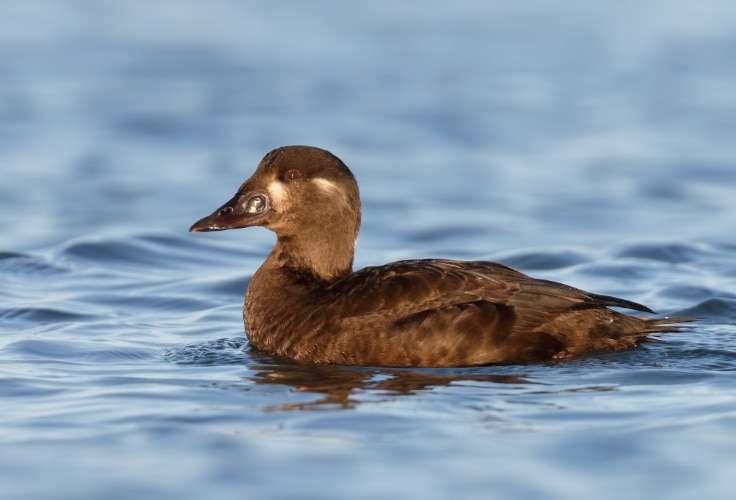
At sea, identification leans on head pattern, bill bulk, and flocking behavior. Surf scoters fly low and fast in compact, twisting flocks; wings produce a clear whistling sound. On the water they dive repeatedly, often in synchrony, to take benthic prey and can “spring-dive” forward with partly open wings in swell. Males during courtship give liquid, gurgling notes, while females utter harsher crow-like calls. Diet is broad but dominated by marine invertebrates; on breeding lakes adults and ducklings take a variety of freshwater invertebrates.
Breeding occurs sparsely across the boreal forest from western Alaska through the Northwest Territories to northern Quebec and Labrador, with nests placed under low conifers or in dense cover slightly upland from lakes and ponds. Broods use small to medium fish-poor wetlands. In winter, the species concentrates in shallow coastal waters – estuaries, inlets, and protected bays, particularly abundant in British Columbia (including the Strait of Georgia), San Francisco Bay, Chesapeake Bay, and Delaware Bay; inland occurrences are uncommon and mostly during migration.
Surf scoters remain common overall but may be declining in parts of the range. Coastal development, disturbance, and contamination (including oil spills and heavy metals) affect major wintering sites, while rapid change at high latitudes may disrupt breeding phenology and food resources. Harvest is monitored alongside other scoters. Protection and restoration of coastal feeding areas and boreal wetlands are central to maintaining this emblematic sea duck.
White-Winged Scoter
Melanitta deglandi
- Identification: Large dark sea duck with a white wing patch; males are black with a small white mark under the eye and a thick bill with knob, females brown with two pale face spots.
- Where found: Breeds across Alaska and western to central Canada, sparingly in eastern Canada; winters mainly along both coasts and the Great Lakes.
- How to spot: Look for the bold white wing patch in flight and the sloping head profile; usually seen in large coastal flocks diving for mollusks.
- Conservation status: Least Concern globally; considered stable overall but vulnerable to habitat loss, pollution, and oil spills.

The white-winged scoter is the largest scoter in North America and one of the most distinctive sea ducks in coastal flocks. Adults measure 48 to 58 centimeters (18.9 to 22.8 inches) in length, with a heavy body and thick, sloping bill that set them apart from other sea ducks once familiar.
Adult males are striking in all-dark plumage, accented by a small white crescent beneath the eye and a bold white wing patch visible in flight. Their wedge-shaped head and orange-tipped bill with a black basal knob add to their distinctive look. Females are slightly smaller and browner, marked with two rounded whitish cheek patches and a darker, more subdued bill. Juveniles resemble females but are paler overall with less distinct whitish facial spots. Unlike surf scoters, white-winged lack a white forehead patch, and their face markings are smaller and oval.

In the field, they are usually spotted in flocks sitting low in the water, diving repeatedly for prey. Flight is fast and direct, often in lines or strings low over the sea. Their wings produce a loud whistling sound in flight. White-winged scoters are not especially vocal, though females sometimes utter low guttural notes when defending broods. They feed mainly on mollusks such as mussels and clams, as well as crustaceans and small fish, which they take by diving with both wings and feet.
This species breeds mainly across boreal and subarctic regions of Alaska and western to central Canada, with scattered sites in Ontario, Quebec, and Labrador. Nesting usually occurs on large lakes with shrub-covered islands, sometimes at surprising distances from water. After breeding, flocks move to coastal staging areas before heading to wintering grounds. In winter, White-winged scoters are concentrated along both the Pacific and Atlantic coasts, from Alaska and British Columbia south to Baja California, and from Newfoundland and the Gulf of St. Lawrence south to Florida. Smaller numbers winter on the Great Lakes, where they feed heavily on invasive zebra and quagga mussels.
Populations appear fairly stable, though information on trends is limited. Oil spills, heavy metal contamination in shellfish, and destruction of boreal breeding habitat are major concerns. Scoters are also hunted, with annual harvests across species carefully monitored. Despite these threats, the white-winged scoter remains widespread and is considered a species of relatively low conservation concern.
Black Scoter
Melanitta americana
- Identification: Stocky sea duck; males are entirely black with a butter-yellow bill knob, females dark brown with pale cheeks and contrasting dark crown.
- Where found: Breeds in subarctic Alaska and northern Quebec-Labrador; winters along both North American coasts and locally on the Great Lakes.
- How to spot: Look for tight flocks diving near shore; note the pot-bellied silhouette, rounded head, relatively long pointed tail, and in flight the silvery underwing of the primaries; males whistle plaintively in winter flocks.
- Conservation status: Near Threatened globally; key concerns include hunting pressure, low reproductive potential, contaminants, and climate change.
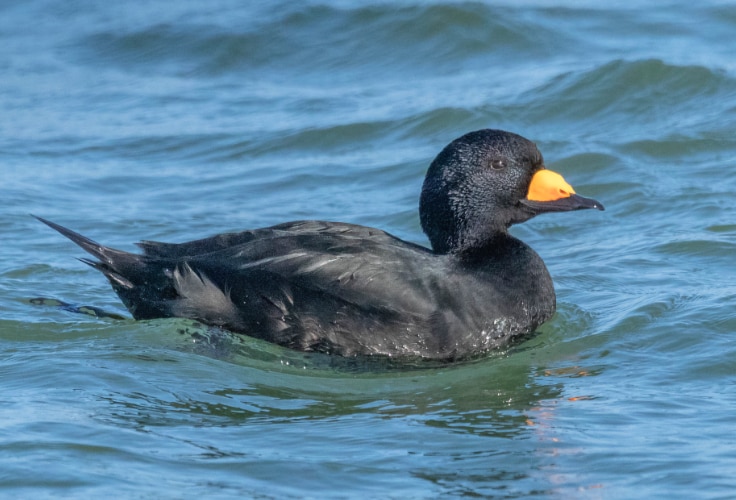
The black scoter is the darkest of North America’s three scoters and a hallmark of winter sea-duck flocks on both coasts. Adults measure 43 to 55 centimeters (16.9 to 21.7 inches) in length. Its compact, pot-bellied build, rounded head, narrow outer primary, and relatively long, pointed tail make a distinctive structural package among coastal ducks.
Males are uniform black with a conspicuous butter-yellow swelling at the base of the bill. Females are chocolate-brown with pale cheeks and foreneck that contrast with a dark cap; immatures resemble females but show paler upperparts and mottled whitish underparts. In flight, both sexes show a conspicuous silvery under surface to the primaries and coverts that contrasts with the otherwise dark wing lining. Young males in fall often begin to show scattered black body feathers and a narrow yellow line along the nostril.
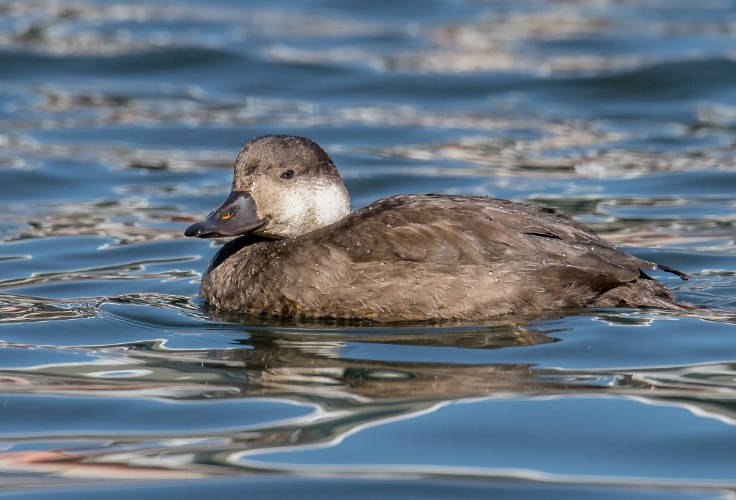
In the field, black scoters gather in tight, often noisy winter flocks just offshore, diving repeatedly for prey. They fly low over the water in loose lines that bunch and stretch, sometimes skimming the surface before lifting. Courting males are notably vocal, giving a plaintive, musical single-note whistle, variously rendered as “whuuuuw” or “whe-oo-hoo,” and the wings of adult males can produce a strong whistling sound in flight. They feed mainly by diving, swallowing most prey underwater; diet is dominated by marine mollusks and crustaceans near the coast, with aquatic insects and other invertebrates taken on freshwater breeding lakes.
Breeding is subarctic and disjunct in North America: a western population centered on coastal and alpine tundra lakes across Alaska, and an eastern population in northern Quebec with records in Labrador and Newfoundland. Nests are on the ground, typically within about thirty meters of water, tucked in grasses, moss, or low shrubs. Outside the breeding season they concentrate in shallow near-shore waters along both coasts, from Alaska and British Columbia to northern Baja California in the Pacific, and from Newfoundland south to northern Florida (with small numbers along the Gulf Coast and inland on the Great Lakes).
Populations of black scoters have raised conservation concern due to slow reproductive rates and sensitivity to changes in coastal food webs. The species has undergone substantial long-term declines, losing more than half of its historical population, though recent trends appear relatively stable under current management. Regulated hunting continues under federal frameworks. Ongoing risks include depletion of mussel beds, heavy-metal contamination, climate-related habitat change, and potential disturbance or habitat degradation from oil and gas activities; monitoring and habitat protection at key staging, molting, and wintering areas remain priorities.
Long-Tailed Duck
Clangula hyemalis
- Identification: Small to medium duck with striking plumage; males show long central tail feathers and seasonal black, white, and gray contrasts, females brownish with pale face and dark cheek patch.
- Where found: Breeds across Arctic tundra regions of Alaska and northern Canada; winters widely on both North American coasts and on the Great Lakes.
- How to spot: Look for flocks flying low over water with erratic wingbeats; males in winter display long tails and bright white plumage, while both sexes give a loud, melodic yodeling call.
- Conservation status: Vulnerable globally; the species has lost over half of its numbers in recent decades, with concerns linked to climate-driven habitat changes, food availability, and historical bycatch in fishing nets.
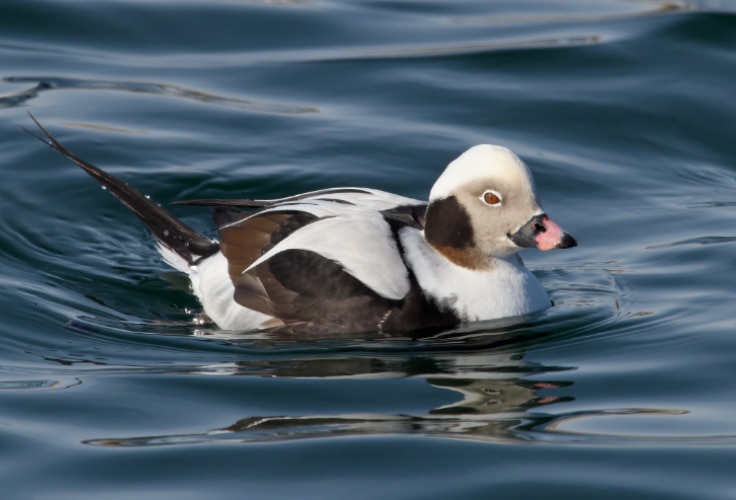
The long-tailed duck is one of the most distinctive sea ducks in the Northern Hemisphere, celebrated for its striking seasonal plumages and its remarkable diving ability. Adults measure 38 to 47 centimeters (15.0 to 18.5 inches) in length, with males notably larger and bearing elongated tail streamers that add to their unmistakable profile on open water. This species is among the deepest-diving of all ducks, regularly reaching depths far beyond those of other waterfowl.
Males undergo three plumage changes each year, a unique trait among ducks. In winter they are mostly white with black wings, dark breast, and two long black tail feathers. By summer the plumage darkens, showing more brown and gray, with the long tail still prominent. Females are brown overall with a paler face set off by a dark cheek patch; they lack the male’s long tail feathers. Juveniles resemble females but are duller, with softer facial markings. The bill of males shows a pinkish band, while females retain a grayish bill.

In the field, long-tailed ducks are highly vocal and social outside the breeding season. The male’s call is a rich, yodeling series of nasal notes that often carries across flocks gathered offshore. They fly low and fast, often twisting and veering in erratic patterns, with a distinctive wingbeat that barely rises above the body. On the water they dive almost continuously, flapping their wings underwater to propel themselves toward the bottom. Their diet varies with season and location but centers on aquatic invertebrates such as crustaceans, mollusks, insects, and fish eggs, with dives recorded at depths exceeding 60 meters (200 feet).
Breeding occurs across the high Arctic, from coastal Alaska and the Canadian Archipelago to northern Labrador and Hudson Bay. They nest on tundra ponds, lakes, and coastal wetlands, often in loose colonies. Once breeding ends, long-tailed ducks disperse to marine and inland wintering areas. In North America they concentrate in large numbers on the Great Lakes, the Gulf of St. Lawrence, and offshore waters from Alaska and British Columbia south to Oregon, and from Newfoundland south to the Chesapeake Bay. Some remain as far north as ice conditions permit, forming immense flocks in open leads.
Despite their wide range, populations have experienced steep declines in recent decades, with particularly sharp losses noted on the Great Lakes. Historical entanglement in fishing nets once killed tens of thousands annually, and current threats likely include shifting ocean conditions, prey depletion from overfishing, lead exposure, and climate change impacts on Arctic breeding habitats. Conservation efforts focus on monitoring populations, reducing bycatch, and maintaining the integrity of Arctic and marine ecosystems that sustain this highly specialized duck.
Common Eider
Somateria mollissima
- Identification: Very large, heavy-bodied sea duck with a wedge-shaped bill and long sloping head; males mostly white with black underparts and green nape, females warm brown with dark barring.
- Where found: Breeds in colonies across Arctic and subarctic coasts of Alaska, Canada, and northeastern U.S.; winters in large numbers along both Atlantic and Pacific coasts where open water remains.
- How to spot: Look for dense flocks diving near rocky shores and islands; males show a striking black-and-white pattern with greenish nape, while females have barred brown plumage and a distinctive head-and-bill profile.
- Conservation status: Near Threatened globally; populations stable in some regions but declining in others; pressures include hunting, oil spills, food resource depletion, and bycatch in fishing nets.

The common eider is among the heaviest and most conspicuous sea ducks in North America, an iconic breeder of northern coasts and islands. Adults measure 50 to 71 centimeters (19.7 to 28.0 inches) in length and have a bulky body, short neck, and sloping forehead that gives the bill and head a distinctive triangular profile. Their immense flocks along rocky coasts in winter are a hallmark of northern seascapes.
Males in breeding plumage are unmistakable, with white upperparts, black underparts and crown, and a pale green wash on the nape. Their bill is long and wedge-shaped, varying from olive-gray to orange depending on subspecies. Females are barred in shades of warm brown with a pale eye-ring and faint stripe through the eye; their plumage provides excellent camouflage on nesting islands. Juveniles resemble females but are plainer, while young males gradually acquire the bold black-and-white adult plumage over several years.

In the field, eiders are often first noticed in large rafts close to shore, swimming with strong strokes or diving in synchrony. They fly in long, undulating strings with slow wingbeats, sometimes gliding briefly. Males give soft cooing calls during courtship, while alarmed flocks produce harsh, grating notes. Feeding takes place by diving to shallow rocky bottoms and kelp beds, where they seize mussels, sea urchins, and other benthic invertebrates with their powerful bills. Prey is usually brought to the surface before being swallowed.
In North America, common eiders breed in colonies on coastal islands and promontories from Alaska across the Canadian Arctic and south to Newfoundland, Nova Scotia, and Maine, with smaller colonies in New Hampshire and Massachusetts. Nests are placed on the ground near water, often sheltered by vegetation, driftwood, or rocks. In winter, huge concentrations occur along the coasts of Newfoundland, the Gulf of St. Lawrence, the Bay of Fundy, and New England, while Pacific populations winter in the Aleutians, Bering Sea, and southern Alaska. They remain in the north as long as open water permits, often along ice edges.
Conservation history is mixed: populations along the southern Atlantic once collapsed due to market hunting in the 19th century but rebounded with protection. Today, some Arctic populations show declines linked to subsistence hunting, oil spills, lead and heavy-metal contamination, and drowning in gill nets. Overharvest of mussels and urchins, as well as coastal aquaculture, has reduced prey availability in parts of their range. Despite these threats, common eiders remain locally abundant, though continued monitoring and protection of nesting colonies and wintering habitats are essential.
King Eider
Somateria spectabilis
- Identification: Large sea duck with a compact build and rounded head; males show a powder-blue crown and nape, green cheeks, and a huge orange frontal “knob” on the bill; females rich brown with crescent-shaped barring.
- Where found: Breeds on Arctic tundra coasts and islands from Alaska across northern Canada; winters mainly in the Bering Sea, around Greenland and Labrador, and south along the Atlantic to the Mid-Atlantic and, rarely, to the Great Lakes and Pacific Coast.
- How to spot: Scan offshore flocks for the male’s orange bill knob, black back with small “sails” from long scapulars, and a bold white forewing patch visible even on the closed wing.
- Conservation status: Least Concern globally; key concerns include climate change, oil and gas development and spills, and poorly quantified hunting impacts.
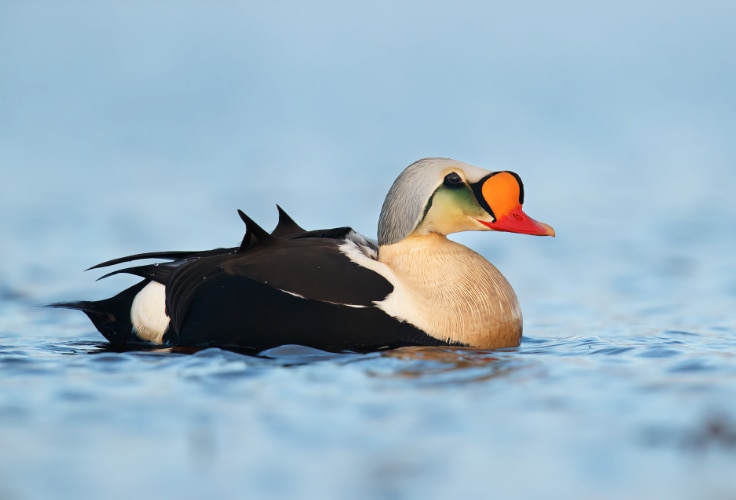
The king eider is the Arctic’s showiest duck, a high-latitude specialist whose winter flocks and spring migrations define northern seas. Adults measure 47 to 64 centimeters (18.5 to 25.2 inches) in length. Compared with common eider, it is slightly smaller and more compact, with a rounder head, shorter bill, and a distinctive upturned gape line that suggests a “smile.”
Males in breeding plumage are unmistakable: a powder-blue crown and nape, pale green cheeks etched by narrow black-and-white lines, a massive orange frontal lobe on the bill, white breast and upper back washed buff to salmon, black body, and a large white patch on the forewing that shows even when the wing is folded. Long black scapulars form small triangular “sails.” Females are deep rufous-brown with crescent-shaped barring and a pale eye ring extending into a faint eyestripe; their scapulars can also form short sails. Juveniles resemble females, with young males darkening and adding white on the breast and rump through their first winter.
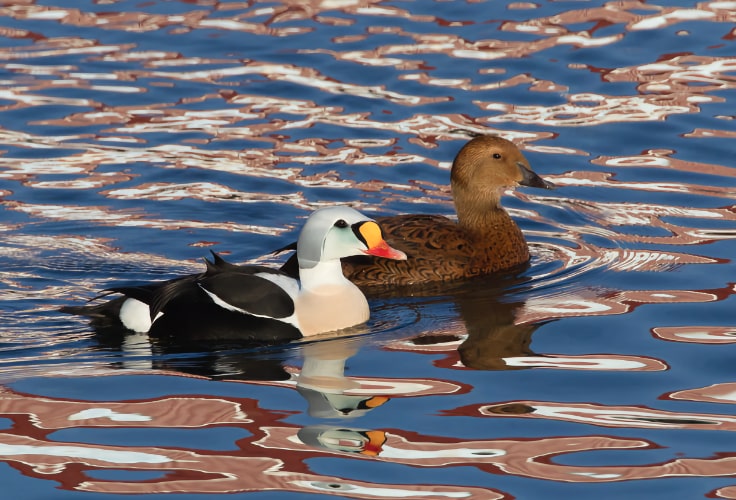
In the field, king eiders travel in long, low, undulating lines over the sea and can form immense migrating flocks. Flight is rapid and direct, yet buoyant. Males give soft, dove-like coos; wings may whistle in dense flocks. On the water they are powerful divers, often in tightly synchronized groups, regularly foraging on the bottom and capable of very deep dives. Diet at sea centers on benthic invertebrates, especially mollusks, crustaceans, and echinoderms; on tundra ponds in spring they take insect larvae and some plant material.
Breeding is across Arctic coasts and islands from Alaska east through the Canadian Arctic Archipelago to Hudson and James Bays, with local nesting along northern Quebec and likely northern Labrador. Nests are on the ground near water or, at times, on drier sites, often using shelter from rocks, hummocks, driftwood, or sparse vegetation. In winter, they concentrate mainly in the Bering Sea and around Greenland and Labrador, with smaller numbers extending south along the Atlantic as far as Virginia and rarely to the Great Lakes or Pacific Coast.
Abundance varies widely by region and year, with some colonies fluctuating greatly. Long-term regional declines and recent acceleration of losses have raised concern despite broad distribution. Ongoing risks include rapid Arctic warming, oil and gas development and potential spills, disturbance, and unknown but potentially substantial hunting take in parts of the range. Priorities include continued population monitoring across flyways, bycatch and harvest assessment, and protection of critical staging, molting, and wintering habitats near the ice edge and in shallow coastal waters.
Harlequin Duck
Histrionicus histrionicus
- Identification: Small duck; males are unmistakable with slate-blue body, bold white stripes, chestnut flanks, and white facial crescents; females brown with pale facial patches.
- Where found: Breeds on fast-flowing rivers and streams from Alaska, western Canada, and the northern Rockies east to Labrador and Newfoundland; winters along rocky coasts of the Pacific and Atlantic.
- How to spot: Look for pairs or small groups near white-water rivers in summer and flocks close to surf-battered shorelines in winter; males are striking, while females show a white spot behind the eye and smaller bill than scoters.
- Conservation status: Least Concern globally; populations stable in the west but smaller and historically reduced in the east; threats include oil spills, logging impacts on stream habitats, and pollution.

The harlequin duck is one of North America’s most striking ducks, renowned for its bold plumage and preference for turbulent waters. Adults are small sea ducks measuring 33 to 46 centimeters (13.0 to 18.1 inches) in length. Unlike many ducks, it thrives in high-energy environments, from mountain rapids to storm-swept coasts, where its agility makes it a specialist.
Males in breeding plumage are unmistakable, with a slate-blue body crossed by white bars and collars, chestnut sides, and distinctive white patches at the face and ear. Black streaks bordered by white and amber lines crown the head, and long scapulars add to the ornate look. Females are more subdued in brown, but show a white spot behind the eye and occasional pale patches on the face. Juveniles and immatures resemble females, with young males gradually acquiring adult plumage after their second year.

In the field, harlequin ducks often call with high-pitched squeaks that carry above rushing water. They are strong but erratic fliers, often skimming low over rivers or coastal waves, and they land by skidding across the surface. On rivers, they clamber easily over rocks and boulders, while on the sea they are superb divers, using their feet and partially spread wings to forage in rough surf. Their diet is entirely animal, shifting from aquatic insects and fish eggs in breeding streams to crabs, amphipods, and mollusks in winter coastal habitats.
Breeding occurs in two main regions: western North America, from Alaska south through British Columbia, the Cascades, and northern Rockies; and eastern Canada, from Labrador south into Quebec, Newfoundland, and northern New Brunswick. In winter, harlequin ducks concentrate along rocky coasts, especially in Alaska, British Columbia, and New England, with major numbers in Maine’s outer bays. Smaller groups winter in Nova Scotia and Newfoundland, while scattered birds appear south along the Atlantic Coast to Virginia and rarely farther.
Populations in the Pacific are more numerous than those in the Atlantic, where numbers remain well below historic levels. While overall status is secure, the species is vulnerable to oil spills, habitat disruption from logging in breeding watersheds, and bioaccumulation of contaminants in marine environments. Careful management of rivers and coasts helps ensure the persistence of this hardy, wave-dancing duck.
Barrow’s Goldeneye
Bucephala islandica
- Identification: Medium-sized, compact diving duck with steep forehead, puffy nape, and short, deep-based bill; males show a purple-glossed head with a crescent-shaped white patch at the face, females have a chocolate-brown head and gray body.
- Where found: Breeds from central Alaska south to northern California, with a small population in eastern Quebec; winters mainly along the northeastern Pacific Coast and locally inland, with eastern birds centered in the St. Lawrence Estuary.
- How to spot: Separate from common goldeneye by the male’s crescent face patch, more black on the back and scapulars, and the blockier head with a steep forehead; listen for loud wing-whistles and watch for tight diving flocks over mussel beds and rocky shorelines.
- Conservation status: Least Concern globally; overall stable but with localized declines; key risks include oil spills and pollutants on wintering grounds, heavy-metal accumulation and disturbance at breeding lakes.
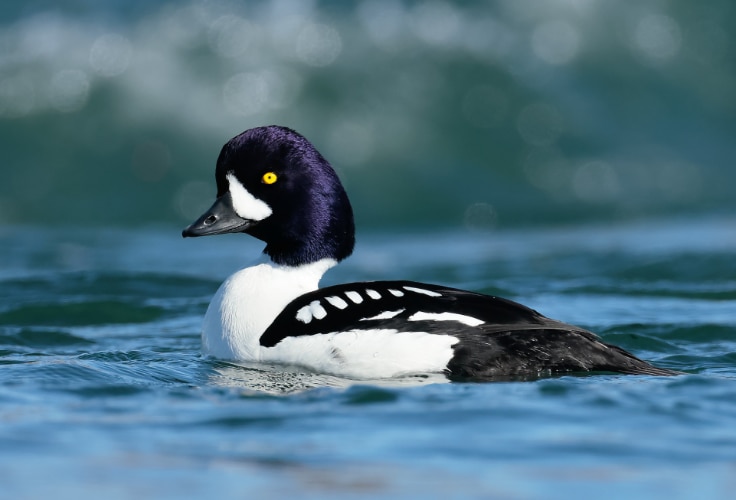
Barrow’s goldeneye is the goldeneye of the West, with a far more limited range than the common goldeneye. Adults are medium-sized diving ducks, measuring 43 to 49 centimeters (16.9 to 19.3 inches). In profile, the species shows a steep, almost vertical forecrown rising to a peak above the eye, a puffy rear crown, and a short, stubby bill; bright amber irises and a piercing wing-whistle complete the impression.
Males in breeding plumage are striking: a purplish-black head with a crisp white crescent between bill and eye, white breast and sides set off against a black back, wings, and tail, and mostly black scapulars punctuated by white spots. Females show a dark brown head, slate-gray upperparts, and white underparts, with a shorter, deeper-based bill than common goldeneye. Juveniles start duller with browner irises and gradually acquire adult features. These traits, together with the male’s crescent-shaped face patch and the species’ blockier head profile, distinguish Barrow’s from the more widespread common goldeneye.
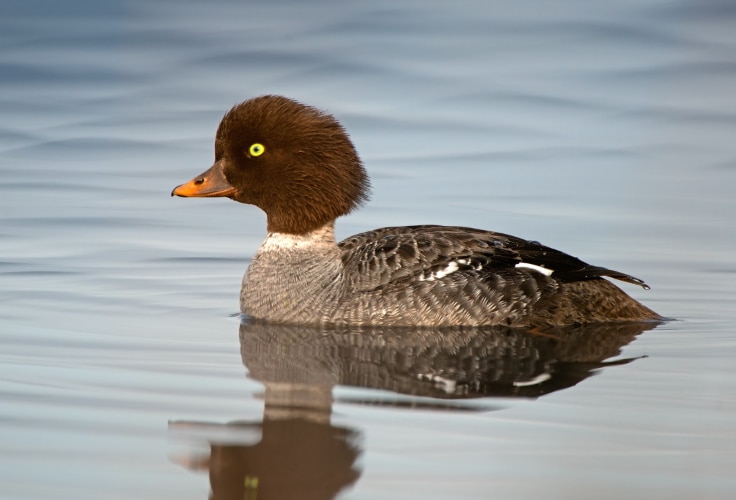
On the water, Barrow’s goldeneyes dive frequently and may surface together in synchronized bouts, especially in winter flocks. Flight is fast and low with audible wing-whistles; birds patter along the surface before lifting. They forage by diving in shallow water along rocky coasts, estuaries, and clear lakes, taking aquatic invertebrates and fish eggs; vegetation is a minor diet component. Pairs or small groups are typical in winter, and territorial pairs dominate breeding lakes.
Breeding is concentrated west of the Rockies from central Alaska through Yukon and interior British Columbia into the Cascades and northern Rockies, with scattered records south to Colorado and historically into northern California. A small disjunct population breeds on high plateaus along the north shore of the St. Lawrence River in eastern Quebec. Nesting is in cavities, in forest near lakes, ponds, beaver impoundments, and subalpine waters. In winter, most birds remain on the northeastern Pacific Coast from Kodiak Island and southeast Alaska through British Columbia to Puget Sound, with smaller numbers farther south and at select inland sites where rivers and lakes stay ice-free. In the East, the primary wintering hub is the St. Lawrence Estuary, with scattered small numbers elsewhere in Atlantic Canada and New England and rare occurrences on the Great Lakes.
Populations are generally considered stable at a broad scale, but localized declines have been noted, particularly in eastern Canada and parts of Alaska. The species’ reliance on large cavity trees and clear, low-vegetation lakes makes it sensitive to timber extraction and shoreline development. Additional pressures include oil spills and industrial pollutants on crowded wintering grounds, bioaccumulation of heavy metals through prey, and disturbance at breeding sites. Given the relatively small global population and concentrated distribution, continued monitoring and protection of mature nest trees, clean coastal foraging areas, and key wintering bays are important.
Spectacled Eider
Somateria fischeri
- Identification: Medium-sized eider with distinctive pale “goggles” around the eyes; males show olive head, orange bill, and white spectacles, females are brown with pale facial goggles.
- Where found: Breeds in coastal tundra wetlands of western and northern Alaska and northeastern Siberia; winters in dense flocks among pack ice of the Bering Sea.
- How to spot: Look for the bold eye “spectacles” visible even on females and juveniles; males are unmistakable with their bright head and carrot-orange bill.
- Conservation status: Near Threatened globally; populations declining due to habitat loss, hunting, pollution, and lead poisoning.
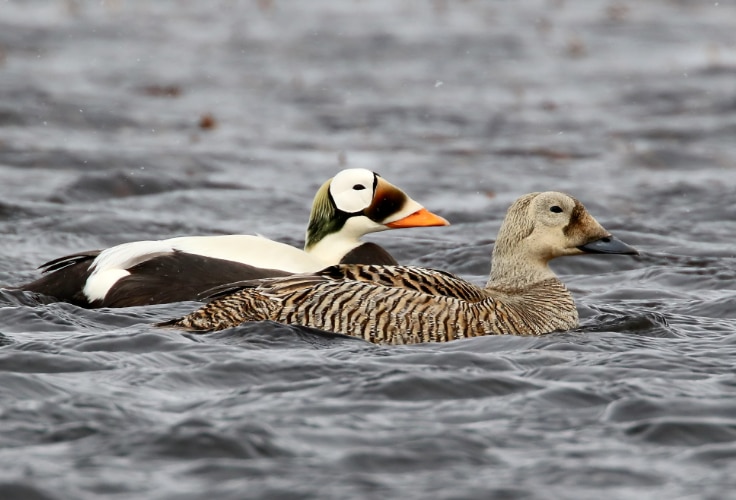
The spectacled eider is one of the most specialized and elusive sea ducks of the Arctic, notable for its striking facial “goggles.” Adults average 50 to 53 centimeters (19.7 to 20.9 inches) in length, making them medium-sized for an eider but smaller than the common eider. Their compact form and preference for remote tundra wetlands and sea-ice zones make them one of the least frequently seen North American ducks.
Males in breeding plumage are unmistakable, with an olive-green head, bold white spectacles around the eyes, dark chest, and a bright orange bill. The body is patterned with black and white, and the neck shows shaggy, uneven feathering. Females are brown overall with faint barring, set apart from other female eiders by the pale goggles on the face. Juveniles resemble females but are paler, and even young birds retain a hint of the spectacle pattern. Males in eclipse plumage are duller but still show traces of the distinctive face markings.

In the field, spectacled eiders are recognized by their “goggled” appearance and compact shape. They form tight flocks in coastal lagoons and enormous rafts on the sea in winter, sometimes numbering in the tens of thousands. Their flight is rapid and low over the water, with steady wingbeats. They are relatively quiet birds, though females give guttural croaks when alarmed and a fast clucking call to gather ducklings. They feed mainly by diving, consuming benthic clams and other invertebrates in the Bering Sea, and switch to insects, larvae, and plant matter in tundra ponds during breeding.
In North America, breeding is concentrated in two regions of Alaska: the Yukon-Kuskokwim Delta in the west and coastal wetlands along the Beaufort and Chukchi Seas in the north. During migration they remain offshore in Arctic waters, before concentrating in winter in a relatively small area of the Bering Sea, where they gather in dense flocks among pack ice. Nests are built on the ground in tundra meadows or near ponds, often concealed among sedges and dwarf willows.
Spectacled eiders have undergone significant population declines in recent decades, and although conservation measures have slowed losses, numbers remain a concern. Primary threats include petroleum development in Arctic Alaska, subsistence hunting, lead poisoning from spent shot, and heavy metal or marine pollution. Dependence on sea-ice ecosystems also makes them vulnerable to climate change. Long-term monitoring and international protection remain essential for sustaining this unusual and highly specialized sea duck.
Steller’s Eider
Polysticta stelleri
- Identification: Smallest eider, males striking with white head, black eye patch, and peachy underparts; females mottled chocolate-brown with pale eye-ring and white-edged wings.
- Where found: Breeds mainly in coastal Arctic tundra of Russia and northern Alaska; winters in flocks along the Aleutian Islands, Bering Sea, and northern Europe.
- How to spot: Males unmistakable in breeding plumage; both sexes show bluish speculum with white borders and white underwings, and often dive synchronously in groups.
- Conservation status: Vulnerable globally; red-listed in the U.S.; populations declining due to habitat change, oil development, overfishing, and lead poisoning.

Steller’s eider is the smallest and most distinctive of the North American eiders, only slightly larger than a harlequin duck. Adults measure 43 to 48 centimeters (16.9 to 18.9 inches) in length and are compact with a short head and slender build. Unlike bulkier eiders, this species often appears more duck-like, with a long, pointed tail and fast, narrow-winged flight.
Males in breeding plumage are unmistakable, with a bright white head, black eye patch, olive-tinged forehead, dark blue throat and collar, peach-buff chest and flanks, and bold black back. Their wings show a bluish speculum between white borders and white upperwing coverts. Females are more subdued, reddish-brown overall with darker feather centers, a pale eye-ring, and broad whitish tips to the wing coverts and secondaries. Juveniles resemble females but are paler, and young males gradually acquire their striking plumage by the second winter.
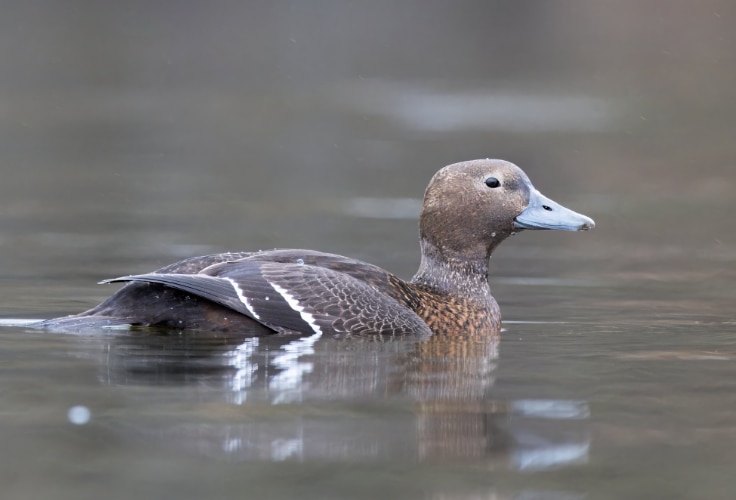
In the field, Steller’s eiders can be recognized by their compact size, rapid wingbeats, and white underwings flashing in flight. They often form tight flocks in winter and are famous for synchronous diving, when groups plunge underwater in unison. Males give soft crooning notes, while females produce guttural rippling calls or loud “qua-haaa” inciting cries. They feed mainly by diving in shallow coastal waters, taking small mollusks, crustaceans, and other invertebrates; during the breeding season they switch to insect larvae in tundra ponds.
In North America, the species breeds only in scattered parts of Arctic Alaska, especially near Utqiagvik (formerly Barrow), though most of the global population nests in Arctic Russia. After breeding, birds move to coastal lagoons and shallow marine bays, especially along the Alaska Peninsula and Aleutian Islands, where they molt and winter in large aggregations. Nesting occurs on tundra near ponds or small lakes, often in low vegetation close to water.
Once far more widespread, Steller’s eider populations have declined steeply over the past half-century. Major threats include oil exploration and spills, overfishing that reduces prey availability, entanglement in fishing gear, and lead poisoning from spent shot. Climate change and loss of Arctic wetland habitat further compound risks. Despite its remote range, intensive monitoring and habitat protection in Alaska and Russia remain critical to ensuring the survival of this unique sea duck.
Mexican Duck
Anas diazi
- Identification: Medium-sized duck, similar to a female mallard but darker and more uniformly brown, with olive to yellowish bill in males and mottled orange-and-black bill in females.
- Where found: Resident from southern Arizona, New Mexico, and west Texas through much of Mexico to Oaxaca; inhabits rivers, reservoirs, ponds, and marshes.
- How to spot: Look for its dark, streaky brown body, pale underwings flashing in flight, and greenish speculum with narrow white trailing edge; smaller and darker than Mallard.
- Conservation status: No formal global assessment; populations considered stable overall, though threatened by hybridization with mallard and wetland loss.
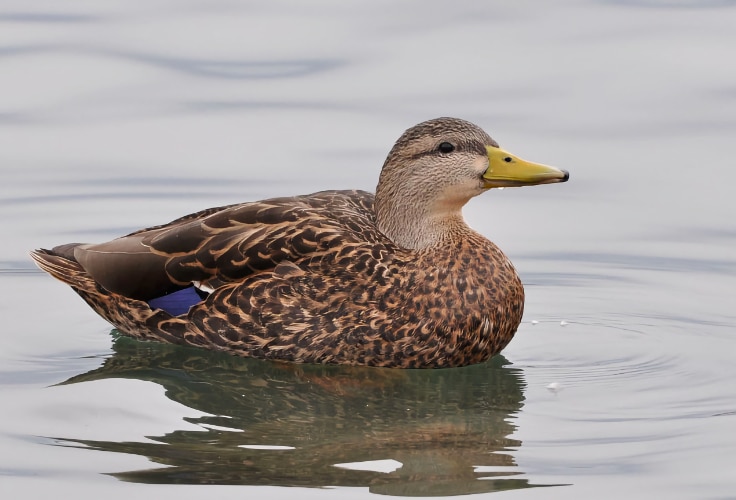
The Mexican duck is a close relative of the mallard and was long considered a subspecies, but it is now recognized as a distinct species native to the southwestern U.S. and Mexico. Adults measure 45 to 55 centimeters (17.7 to 21.7 inches) in length and average slightly smaller and darker than Mallards, with a more uniform body coloration and less contrasting plumage.
Plumage is mottled brown with dark chevrons across the breast and flanks, a contrasting pale belly, and a prominent dark eyeline. The speculum is iridescent greenish-blue with only a narrow white trailing edge, lacking the broad white borders of a mallard. Males have a clear olive or yellow-green bill with a black tip, while females have a more subdued mottled orange-and-brown bill. Juveniles resemble adults but are duller and darker, with notched tail feathers and reduced wing gloss. Unlike mallards, males do not develop a glossy green head or curled black tail feathers.
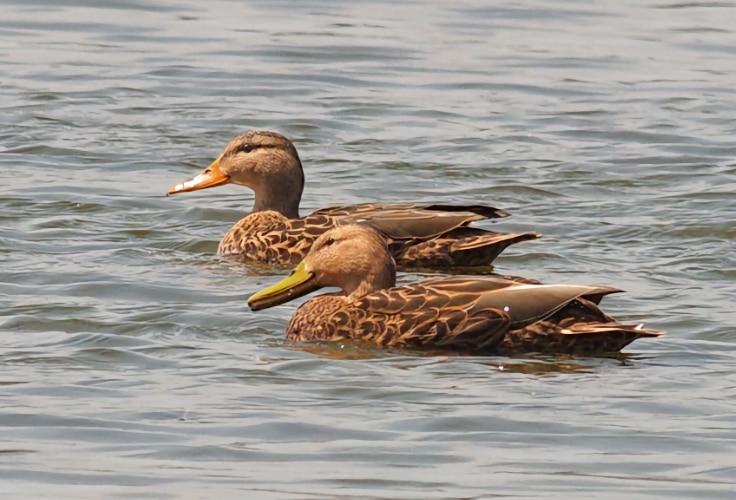
In the field, Mexican ducks are best recognized by their darker, more uniform plumage compared to female mallards, along with their smaller size and distinctive underwing pattern – bright white coverts contrasting against the dark body. They are usually found in pairs or small groups and tend to be wary in wild habitats, though some city park populations in Mexico and the U.S. have grown tame. Foraging is typical of dabbling ducks: they tip up in shallow water, graze along shorelines, and feed in agricultural fields. Diet consists mostly of seeds, grains, and aquatic vegetation, with more invertebrates taken during the breeding season.
The species inhabits a wide range of aquatic environments across its distribution, from natural marshes, rivers, and reservoirs to artificial ponds and agricultural landscapes. In the U.S., it breeds locally in southern Arizona, New Mexico, and west Texas, while the majority of the population occurs in central and southern Mexico, including the volcanic belt. Nests are usually well concealed in dense vegetation, often some distance from water.
Although once listed as Endangered in the U.S., the Mexican duck has proven adaptable to human-altered landscapes, and overall numbers appear stable. The primary conservation concern is hybridization with introduced mallards, particularly in the U.S. and northern Mexico, which threatens the genetic integrity of the species. Loss of natural wetlands and agricultural chemicals also pose risks, but the duck has benefited from the spread of artificial water bodies and crop fields that provide foraging habitat.
Black-Bellied Whistling-Duck
Dendrocygna autumnalis
- Identification: Medium-sized, long-necked duck with chestnut breast, black belly, bold white wing stripe, and bright pink bill and legs.
- Where found: Resident from Mexico through much of Central and America; in the U.S., breeds mainly in southern Texas, Louisiana, Florida, and locally in Arizona, with range slowly expanding northward.
- How to spot: Look for flocks in wetlands, fields, and ponds; unmistakable upright posture, pink bill and legs, and white wing stripe flashing in flight.
- Conservation status: Least Concern globally; populations increasing in the U.S. as range expands, though vulnerable to wetland loss and water quality issues.

The black-bellied whistling-duck is one of the most distinctive ducks in North America, known for its upright, goose-like stance and long pink legs. Adults measure 47 to 51 centimeters (18.5 to 20.1 inches) in length. Unlike most ducks, it perches readily in trees and on fences, and often gathers in large flocks, making it one of the most conspicuous waterfowl of the southern states.
Adults are striking, with a chestnut neck and breast, black belly, bold white wing stripe, and gray face with a narrow dark crown stripe. The bill and legs are bright pink to reddish, giving the species a flamboyant appearance. Sexes look alike. Juveniles are duller brownish overall with a gray bill and legs, but even young birds show a developing white wing stripe and darker belly.
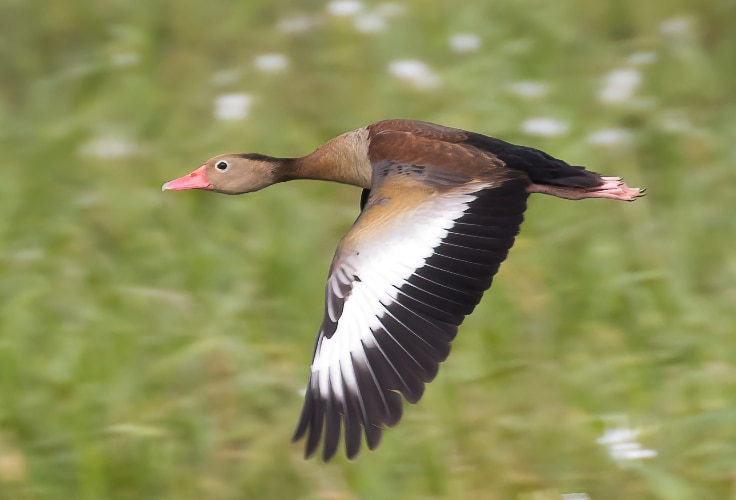
In the field, black-bellied whistling-ducks are easy to identify by their long-necked silhouette, bright pink bill and legs, and noisy calls. Their flight is slow-winged and somewhat lumbering, with legs trailing beyond the tail. They are very vocal, giving high-pitched whistles, “pe-che-che-ne” calls, and softer twittering when loafing. They forage mainly at night in shallow water and agricultural fields, feeding on seeds of grasses, smartweeds, sorghum, rice, and millet, with insects and mollusks taken occasionally.
In the U.S., the core breeding range lies in southern Texas, Louisiana, and Florida, with smaller populations in Arizona and Arkansas. Breeding sites are typically shallow ponds or lakes bordered by savannah, wetlands, or farmland. Pairs often nest in tree cavities, nest boxes, or occasionally on the ground, and females may lay eggs in the nests of other whistling-ducks. Outside the U.S., the species is widespread from Mexico through Central America to much of South America east and west of the Andes.
Populations are stable or increasing across most of their range, and the species is expanding northward in the U.S. They adapt well to human-altered landscapes, especially rice and corn fields, though they can become agricultural pests in some areas. Habitat loss, pesticide exposure, and poor water quality remain potential threats, but overall the black-bellied whistling-duck remains one of the region’s most successful and adaptable waterfowl.
Fulvous Whistling-Duck
Dendrocygna bicolor
- Identification: Tall, long-legged duck with rich caramel-brown body, black back, buff-streaked flanks, blue-gray bill and legs, and all-dark wings.
- Where found: Breeds locally in the southern U.S. (Texas, Louisiana, Florida, formerly California) and across much of Mexico, and Central America.
- How to spot: Look for its upright posture, tawny coloration, and all-dark wings in flight; flocks often gather in rice fields, marshes, and shallow wetlands.
- Conservation status: Least Concern globally; populations generally stable, though locally impacted by habitat loss and pesticide use.
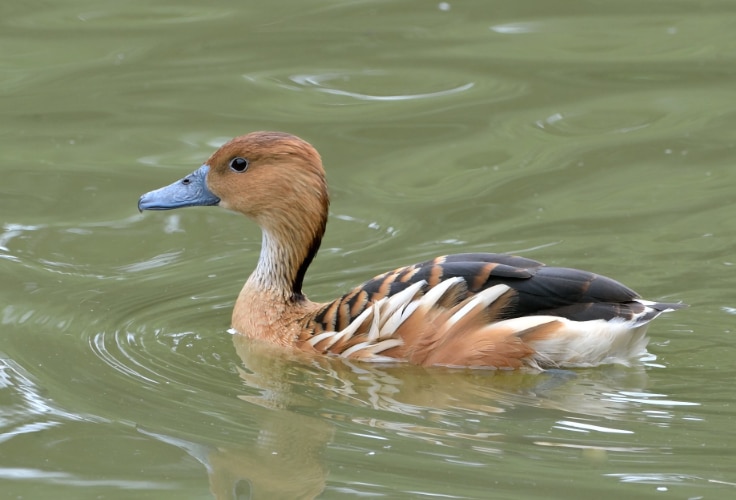
The fulvous whistling-duck is one of the most widespread waterfowl in the world, but in North America it is localized and often tied to rice-growing regions. Adults measure 44 to 53 centimeters (17.3 to 20.9 inches) in length. Their long legs, elongated neck, and upright stance give them a goose-like profile, though they float lower in the water than the black-bellied whistling-duck.
Plumage is a warm tawny-cinnamon overall, with darker brown wings, back, and tail contrasting against pale buff-streaked flanks and whitish upper- and undertail coverts. The face and neck show subtle fine streaking, and the crown and nape are deeper cinnamon-brown. The bill and legs are blue-gray rather than pink, helping distinguish the species from the black-bellied whistling-duck. Juveniles are duller brown with reduced chestnut tones and less distinct flank markings.

Fulvous whistling-ducks are conspicuous and noisy, giving high-pitched two-syllable whistles, often repeated as they fly or while perched in wetlands. They move in loose, irregular flocks, sometimes confused with ibises in flight because of their long-necked silhouette and slow wingbeats. On the water they dabble, tip up, or make shallow dives to feed, consuming primarily seeds of aquatic plants, rice, and other grains, along with occasional insects and mollusks. Unlike the black-bellied whistling-duck, they seldom perch in trees.
In the U.S., breeding occurs locally in southern Texas, Louisiana, and Florida, with small populations formerly in southern California. Beyond North America, they are widespread, nesting across Central and South America. Typical nesting habitat includes marshes, flooded fields, and wetlands with dense emergent vegetation. They often use rice fields, constructing nests among flooded plants. Wintering occurs mainly within the same range, though some northern populations migrate southward.
The species is globally secure, with stable or increasing populations in most regions, though it remains patchy in North America. Agricultural pesticides and drainage of wetlands have caused declines in some areas, and the loss of rice-field habitat can reduce breeding opportunities. Still, its adaptability to altered wetlands has allowed the fulvous whistling-duck to remain widespread and resilient, making it one of the most successful of the whistling-ducks worldwide.
Muscovy Duck
Cairina moschata
- Identification: Very large, heavy-bodied duck with glossy black plumage, bold white wing patches, and bare red facial caruncles; males much larger than females.
- Where found: Native from southern Texas and Mexico through Central and South America; widespread as a domesticated and feral bird, including a large established population in Florida.
- How to spot: Look for its hefty size, long neck, crested crown feathers, red warty face, and white wing patches visible in flight; wild birds are shy, but feral ones are common in parks.
- Conservation status: Least Concern globally, though wild populations have declined due to hunting and forest loss.
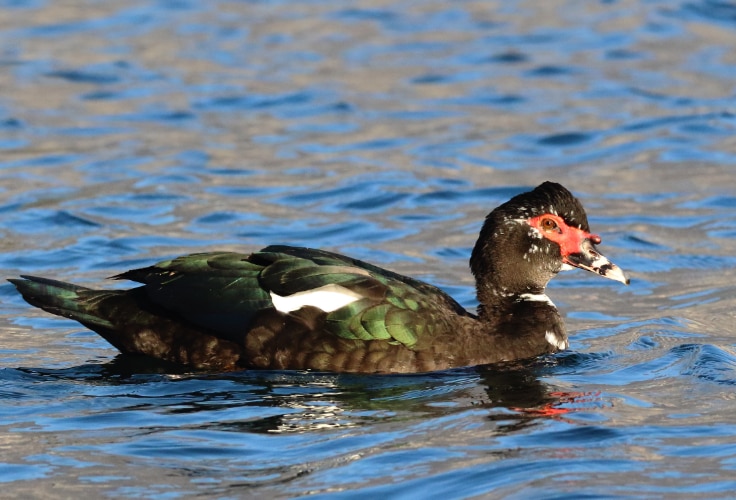
The muscovy duck is the largest duck in the Americas, with adults measuring 66 to 84 centimeters (26.0 to 33.1 inches) in length. It exists in both wild and feral forms: wild birds are shy, wary, and usually seen in remote wetlands, while feral populations descended from domestic stock are bold, tame, and often found in city parks and farms. Their appearance also differs, with wild birds uniform and dark, and feral ones variable, often blotched with white.
Wild muscovy ducks are hefty and dark overall, with glossy black plumage showing green and bronze iridescence, bold white wing patches, and elongated crown feathers forming a short crest. Bare red or pinkish caruncles cover the face, most prominent in males. Females are smaller, duller, and show fewer facial growths, while juveniles are brownish-black with little white in the wings. Feral and domestic birds can be more heavily marked with white across the body and usually show larger caruncles.
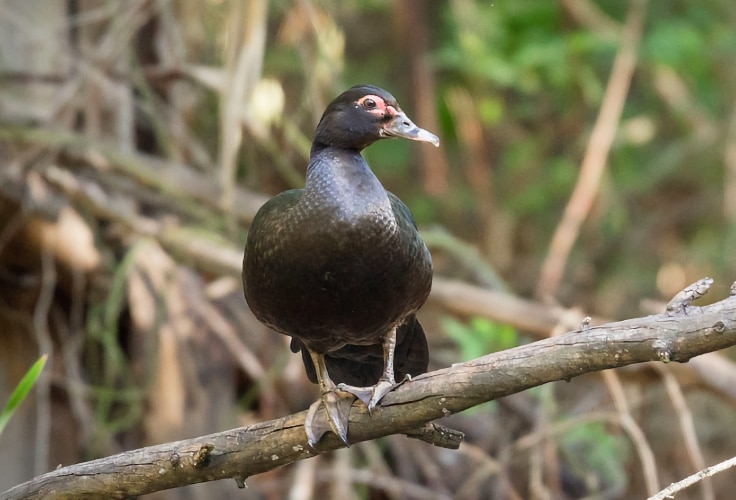
In the field, muscovies stand out by their massive build, upright stance, and white wing patches flashing in flight. Wild birds often perch in tall trees and roost above wetlands, while feral populations walk boldly through open areas and even approach people for food. The species is generally quiet, with males hissing and puffing in courtship and females giving soft croaks or shrill calls to ducklings. Muscovies are versatile feeders, dabbling, grazing, and tipping in shallow water. They take seeds, grasses, aquatic plants, small vertebrates, and insects, with termites a notable favorite, and often feed in agricultural fields at dawn and dusk.
The natural range extends from southern Texas and northeastern Mexico through Central America into lowland South America east and west of the Andes, south to northern Argentina. They inhabit tropical forests, rivers, lakes, and swamps, generally below 1,200 meters (4,000 feet). Nests are placed singly in hollow trees, caves, or dense streamside vegetation, often 2 to 18 meters (6.6 to 59 feet) above ground. In the U.S., wild breeding is restricted to the lower Rio Grande Valley of Texas, though feral populations are firmly established in Florida and scattered across many parks and urban areas.
Wild populations have declined in parts of Mexico and South America due to overhunting and forest loss, particularly the removal of large cavity-bearing trees needed for nesting. Egg collection and hunting pressure remain threats in Central America. However, conservation actions such as artificial nest boxes have boosted populations in northern Mexico and Texas, supporting a modest recovery. Domesticated and feral muscovy ducks, meanwhile, thrive around the world, ensuring the species remains widespread even as its wild populations face challenges.
Hawaiian Duck
Anas wyvilliana
- Identification: Medium-sized, mottled brown duck with chevron-patterned breast and flanks, olive to dark bill, and white underwings; males and females look alike, though females are slightly smaller and paler.
- Where found: Endemic to Hawaii; pure populations now restricted to Kaua’i and parts of Hawai’i Island, with reintroduced but hybridized populations on O’ahu and Maui.
- How to spot: Look for its smaller, darker build compared to a mallard, lack of green head and curled tail in males, and spotted tail feathers in both sexes.
- Conservation status: Vulnerable globally; federally and state-listed as Endangered in the U.S., with hybridization with introduced mallards the primary long-term threat.
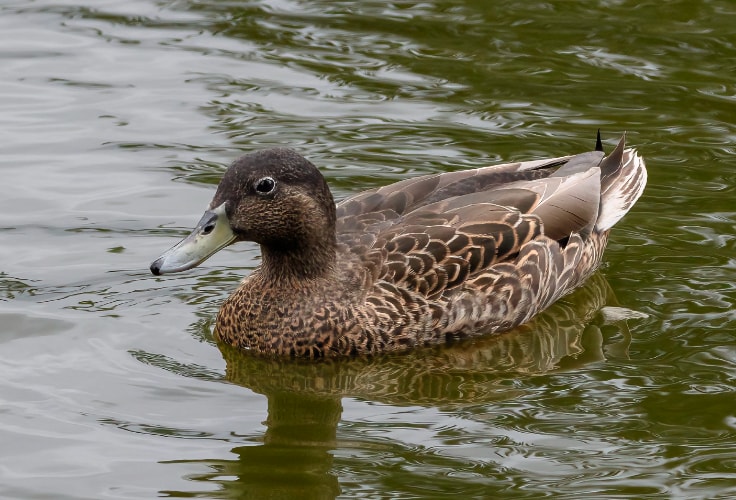
The Hawaiian duck, or koloa, is one of only a handful of waterfowl native to the Hawaiian Islands and the only surviving endemic dabbling duck. Adults measure 40 to 50 centimeters (15.7 to 19.7 inches) in length, making it one of the smallest members of the mallard complex. This species closely resembles a female mallard but is smaller, darker, and more uniformly patterned, with both sexes looking alike.
Plumage is rich brown overall with darker chevrons on the breast, flanks, and back. The chin is mottled in males and plainer buff in females, which may also show a pale supercilium and eye-line. Bills are olive, sometimes with an orange tip in females, and the legs are orange to yellow-orange. The speculum ranges from dull green to bluish, bordered in black and white. Unlike mallards, males do not have a glossy green head or curled tail feathers. Juveniles are similar to adults but paler.

In the field, Hawaiian ducks can be told from mallards by their smaller size, darker plumage, and absence of bright male head or tail markings. They flush readily from wetlands, flying low and fast, and are agile along streams, sometimes springing vertically from plunge pools. Their calls are weaker and less frequent than those of Mallards; females give soft quacks when disturbed, while males are often silent. They forage by dabbling and tipping in shallow water, taking aquatic invertebrates, seeds, and grasses, and also graze in moist uplands and agricultural fields.
Pure populations are now confined to Kaua’i, with smaller re-established groups in montane streams and reservoirs on Hawai’i Island. Ducks released on O’ahu and Maui have largely hybridized with introduced mallards, leaving few if any pure birds there. Hawaiian ducks occupy wetlands from sea level to over 3,000 meters (9,800 feet), including natural marshes, rivers, taro fields, and managed ponds. Nests are typically placed near water in dense vegetation.
Once widespread across the islands, the Hawaiian duck has been reduced to small, fragmented populations. Habitat loss, introduced predators, and hunting all contributed to past declines, but hybridization with feral mallards now poses the greatest long-term threat to its genetic integrity. Conservation programs have included captive breeding, releases, and habitat management, but controlling mallard introductions remains critical for preserving this unique island duck.
Laysan Duck
Anas laysanensis
- Identification: Small, dark brown duck with bold white eye patch and variable white mottling on head and neck; both sexes similar, with males slightly darker and often showing faint green gloss.
- Where found: Endemic to the Northwestern Hawaiian Islands; native to Laysan Island, with additional translocated populations on Midway and other atolls.
- How to spot: Look for its compact, teal-like size, white “comma” around the eye, short spatulate bill with blotching, and tendency to run through swarms of brine flies.
- Conservation status: Critically Endangered globally; fewer than 700 mature birds remain, highly vulnerable to disease, invasive species, and random disasters on its tiny island range.

The Laysan duck is one of the world’s rarest waterfowl and the most range-restricted duck in the United States. Adults measure 38 to 43 centimeters (15.0 to 16.9 inches) in length, making them similar in size to teal. They are stocky, short-billed, and adapted to a terrestrial lifestyle, walking and running more than most ducks and flying only short distances.
Plumage is dark brown with bold darker chevrons across the breast and flanks. Both sexes show a striking white patch or comma around the eye, often with additional white mottling on the head and neck, especially in females and older birds. Males tend to be slightly darker with brighter orange legs and sometimes faint green iridescence on the head. Bills are blotched yellow-green in males and dull orange with black blotching in females. The speculum is green to purple, bordered by dark and pale edges. Juveniles resemble adults but are plainer overall.
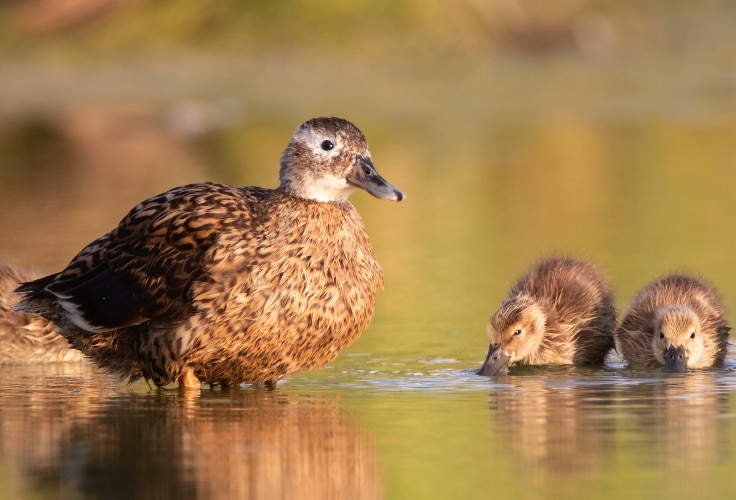
In the field, Laysan ducks are best recognized by their small size, bold eye markings, and terrestrial behavior. They are less inclined to flush than other dabbling ducks, often running to cover instead of flying. They forage in the littoral zones of saline lakes, mudflats, and upland vegetation, snapping up invertebrates, especially swarms of brine flies, by running with bills open and sweeping side to side. They also dabble and tip up in shallow water and graze on seeds and plants. Their calls are quieter and less frequent than those of Mallards, with soft nasal quacks and grating notes.
The species is native to Laysan Island, a small atoll with a hypersaline central lake and dense seabird colonies. Once reduced to fewer than 30 individuals after habitat destruction by introduced rabbits in the early 1900s, the species was saved through protection and later translocations. Ducks now also survive on Midway Atoll and a few other Northwestern Hawaiian Islands, inhabiting saline lakes, seeps, and vegetated wetlands. Nests are well hidden on the ground among grasses or shrubs.
Despite conservation successes, the Laysan duck remains highly precarious. With fewer than 700 mature birds, its survival is threatened by disease outbreaks, drought, invasive species, and extreme weather events such as tsunamis that can swamp its tiny islands. The species is considered a global conservation priority, and ongoing efforts include habitat management, predator control, and establishing additional island populations to reduce extinction risk.
Mandarin Duck
Aix galericulata
- Identification: Small to medium-sized duck with ornate males showing orange “sail” feathers, colorful crests, and red bill; females gray-brown with bold white eye-ring and spotted flanks.
- Where found: Native to East Asia; in North America found as escapees or small feral populations in California, North Carolina, Florida, and scattered elsewhere.
- How to spot: Males are unmistakable in breeding plumage with bright orange sails and facial whiskers; females show narrow white spectacles and dappled flanks, often perching in trees.
- Conservation status: Least Concern globally; main threats in native range include habitat loss and hunting, though stable in many areas.
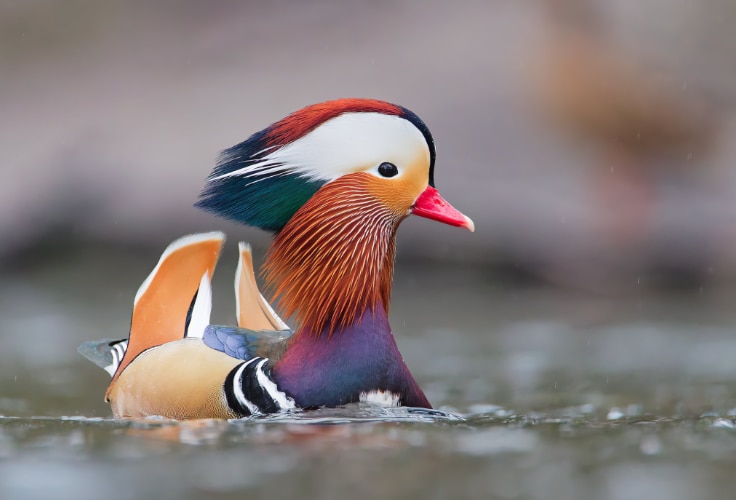
The mandarin duck is one of the most spectacularly ornate birds and, while native to East Asia, it has become an occasional feature of the North American duck scene. Adults measure 41 to 51 centimeters (16.1 to 20.1 inches) in length. Though not native, the species has established small feral populations, especially in California and the southeastern United States, making it a notable exotic among North American ducks.
Males in breeding plumage are unmistakable: they have a green to purplish crown with elongated coppery crest feathers, chestnut “whiskers” along the face and neck, and bold orange sails formed by upturned tertials. The chest is maroon with a white belly, flanks barred with black, orange, and white, and the bill bright red tipped with pale pink. Females are much plainer, with gray-brown plumage, bold white spectacles extending behind the eye, spotted flanks, and a pale-tipped bill. Juveniles resemble females but are duller, with less distinct facial markings. Males in eclipse plumage also resemble females but retain some bill color and structural differences.
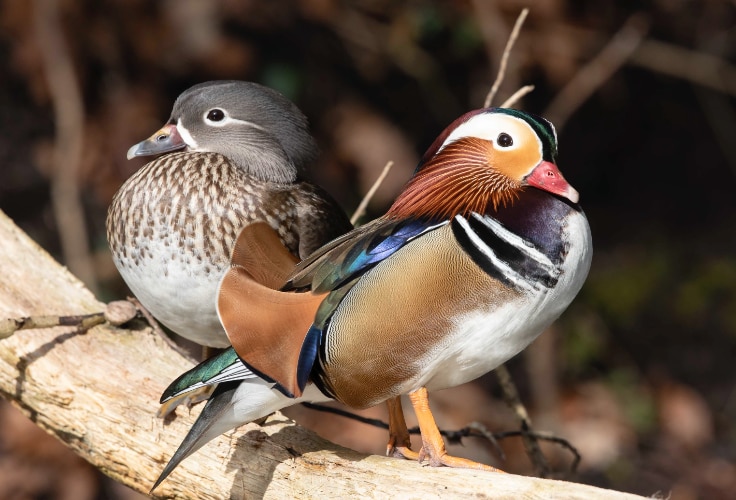
In the field, mandarins are best identified by the male’s gaudy plumage, which has no equivalent among native ducks. Females can be told from similar wood ducks by their narrower eye-ring, finer spotting, and different bill pattern. Both sexes perch readily in trees, especially near water. Their calls are not often heard, but males give rising whistles with a nasal quality, while females utter sharp “kett” notes. Foraging is mostly by dabbling and tipping up for seeds, nuts, aquatic plants, insects, and small invertebrates, with ducklings relying heavily on invertebrates.
In North America, mandarin ducks are found mainly where birds have escaped from collections or been introduced. Established free-flying populations occur in parts of California, Florida, and North Carolina, with occasional sightings in urban parks as far afield as New York City. They use small wooded ponds, slow rivers, and ornamental lakes, and nest in tree cavities, often reusing old woodpecker holes or nest boxes.
Globally, the species remains common, though wild populations in East Asia face pressure from deforestation and hunting. In North America, the species persists only in localized feral groups, and its status here depends entirely on continued escape and reproduction in favorable habitats.
Eurasian Wigeon
Mareca penelope
- Identification: Medium-sized duck; males show chestnut head with buffy crown, gray body, pink breast, and bold white wing patch, females warm brown with subtle barring and spectacles.
- Where found: Breeds across northern Europe and Asia; rare but regular visitor to North America, especially on both coasts and into the interior. Uses shallow wetlands, lakes, and coastal marshes.
- How to spot: Look for the male’s buffy-cream crown stripe and gray body among American wigeons; listen for his sharp whistled “whee-ooo;” females resemble American wigeons but are warmer brown with duller underwings.
- Conservation status: Least Concern globally; threats include wetland drainage, pollution, hunting, and lead poisoning in parts of its native range.

The Eurasian wigeon is the most expected Old World duck to occur in North America, turning up annually in small numbers on both coasts. Adults measure 42 to 52 centimeters (16.5 to 20.5 inches) in length. Their striking plumage and habit of joining flocks of American wigeon make them a regular prize for birders scanning through wintering waterfowl.
Breeding males are elegant, with a rich chestnut head and neck topped by a buffy-cream crown, a gray back and flanks, and a pinkish breast. A large white wing patch flashes in flight, contrasting with the dark green speculum. Females are patterned warm brown, less contrasting than female American wigeon, with a darker head blending into the body and fine barring on the flanks. Juveniles resemble females, while eclipse males are chestnut overall with reduced contrast but still show white in the forewing.

In the field, Eurasian wigeon are most reliably identified by the male’s bright crown and body coloration, along with his sharp, whistled “whee-ooo” call. Females can be trickier to separate from their American relatives, but their warmer brown tones and duller grayish underwings help. Like other wigeons, they feed by dabbling and grazing, often tipping up in shallow water or clipping grasses in wet fields. They sometimes forage alongside swans or geese, taking advantage of vegetation pulled to the surface by the larger birds. Their diet includes aquatic plants, seeds, grasses, and grains, with invertebrates especially important for females and young in summer.
This species breeds widely across northern Eurasia, from Iceland and Britain to Siberia. In North America, it appears mostly in winter, particularly on the Pacific Coast from Alaska to California and along the Atlantic Coast from Newfoundland to the Carolinas. Smaller numbers occur inland on lakes, reservoirs, and marshes, and individuals are occasionally recorded as far south as Mexico and the Caribbean. Nests in the native range are placed on the ground near ponds or marshes, lined with grasses and down.
While globally common and secure, the Eurasian Wigeon has experienced localized declines in parts of Russia and the Middle East. It faces threats from wetland drainage, pollution, disturbance, hunting, and ingestion of lead shot. In North America, it remains an uncommon but expected winter visitor, its presence tied to the distribution of American wigeon flocks where it often blends in but can be found with patient searching.
Tufted Duck
Aythya fuligula
- Identification: Medium-sized duck; males glossy black with white flanks and a distinctive drooping crest, females dark brown with shorter crest and yellow eyes.
- Where found: Breeds widely across Eurasia; rare but regular winter vagrant to North America, recorded across Canada and much of the U.S. in flocks of scaup and ring-necked ducks.
- How to spot: Look for the male’s tufted crest and bold white flanks; females are darker than scaup with smaller, messier white face patch. Both sexes show a strong white wing stripe in flight.
- Conservation status: Least Concern globally; populations stable or increasing, though threatened in parts of the range by habitat loss, hunting, and disturbance.
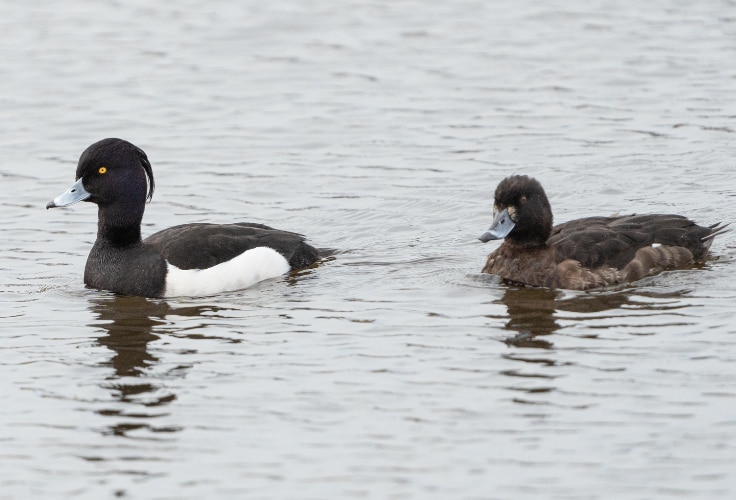
The tufted duck is one of the most frequent Eurasian vagrants to reach North America, with records from all Canadian provinces and at least 30 U.S. states. Adults are medium-sized diving ducks, measuring 40 to 47 centimeters (15.7 to 18.5 inches) in length, and are typically found among scaup flocks on lakes, reservoirs, and coastal waters during the winter months.
Males are striking, with glossy black plumage, bright white flanks, and a long, drooping crest at the rear of the head. Their eyes are golden-yellow, and the bill is bluish with a black tip. Females are dark brown overall with paler flanks, shorter crests, and variable white markings at the base of the bill or undertail. Both sexes show a bold white stripe across the wing in flight. Juveniles resemble females but young males darken quickly, acquiring adult features by their first winter.
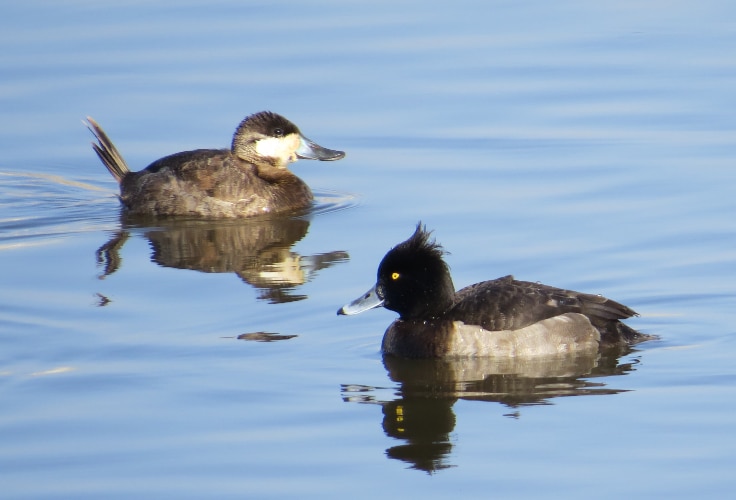
In the field, tufted ducks are best recognized by the male’s tufted crest and strong contrast of black and white. Even when crests are small or worn, males remain darker-backed than scaup, while females are also darker overall and usually show smaller white facial patches. Their flight produces a whistling sound, and they dive with a characteristic forward leap. Calls are rarely heard outside courtship, though males give soft whistles and females utter low quacks and grating notes. Feeding is mainly by diving, taking mollusks, crustaceans, aquatic insects, and aquatic plants, though they also graze or dabble for food when available.
Native to Eurasia, the tufted duck breeds across northern and central Europe and Asia, nesting on islands or shorelines of freshwater lakes, ponds, and rivers. In winter it disperses widely to southern Europe, Africa, and Asia, frequenting calm lakes, reservoirs, and sheltered coastal waters. In North America, it is a scarce but regular winter visitor, usually appearing singly in mixed flocks, especially where scaup are abundant.
This species is globally common and remains one of the few pochards with stable or increasing populations. Nevertheless, it faces threats from wetland drainage, peat extraction, oil pollution, disturbance, and hunting in parts of its range. In North America, it is not established as a breeding bird but remains a prized sighting for birders searching winter flocks of diving ducks.
North America’s Ducks in Perspective
North America’s ducks represent a remarkable mix of residents, long-distance migrants, and occasional visitors from across the oceans. The 38 native species form the core of the continent’s waterfowl diversity, ranging from familiar backyard mallards to highly localized specialists of tundra, prairie, and coastal wetlands. Added to this are introduced birds like the mandarin duck and regular vagrants such as Eurasian wigeon and tufted duck, which remind us that migration routes connect continents in unexpected ways.
Together, these ducks highlight the variety of forms and behaviors within the order Anseriformes, dabblers, divers, sea ducks, and stifftails, each adapted to a particular niche. Their seasonal movements link boreal wetlands, prairie potholes, rivers, and coastal marshes across the hemisphere. For birders and naturalists, they provide some of the most visible and rewarding opportunities to experience migration and to see how local habitats sustain global populations.


